Wondering what to eat in Japan during your first trip to the land of the rising sun? We’ve visited Japan three times and can’t wait to return for a fourth. The best Japan food options are endless. Discover 37 must eat Japanese food favorites. Can you eat them all???
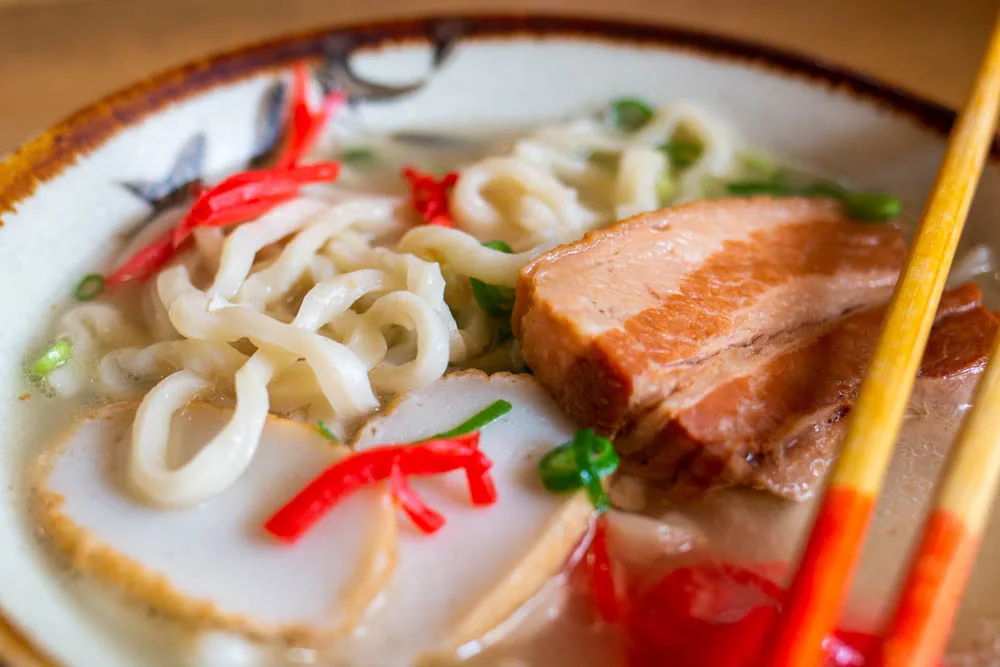
Japanese food is popular around the world but specifically for two dishes – sushi and ramen. These two famous Japanese dishes have made their way around the globe and back again, leaving their culinary mark along the way.
Most people outside of Japan view sushi as a luxury food that they either adore or abhor based on their affinity toward raw fish. And who doesn’t love ramen, the iconic Japanese noodle soup that’s available in most global cities?
If you want to try sushi and ramen in Japan – you’re in luck. These dishes are easy to find at markets and restaurants throughout the country. But we implore you not to stop there. Otherwise, you’ll be missing out on some of the best foods of Japan as well as exciting aspects of Japanese cuisine.
Discover more of the best noodle dishes in the world including three in Japan.
What Is Japanese Cuisine?
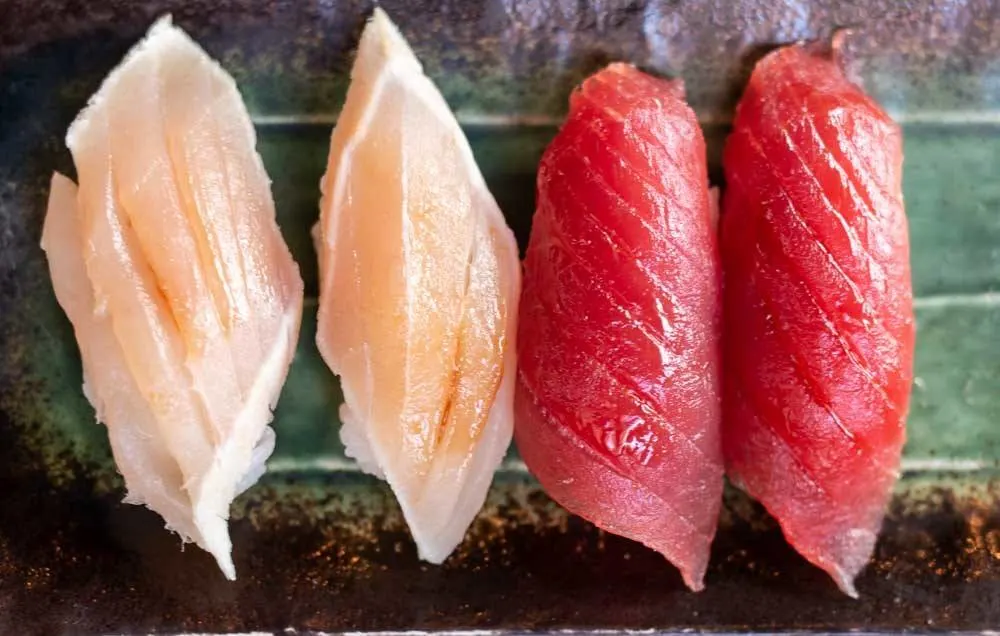
Japanese food, an Asian cuisine that’s developed over centuries, has roots entrenched in the concept of washoku. Literally translating to ‘Japanese food’, washoku is a harmonious way of eating simple, seasonal ingredients like rice, vegetables and seafood.
Evolving over the years, Japanese cuisine incorporates influences from other countries. Portuguese missionaries introduced tempura in the 16th century and, centuries later, the Chinese brought ramen noodles to the Japanese table. Today, both tempura and ramen are two of the most iconic foods of Japan.
Discover our picks for the best Asian dishes.
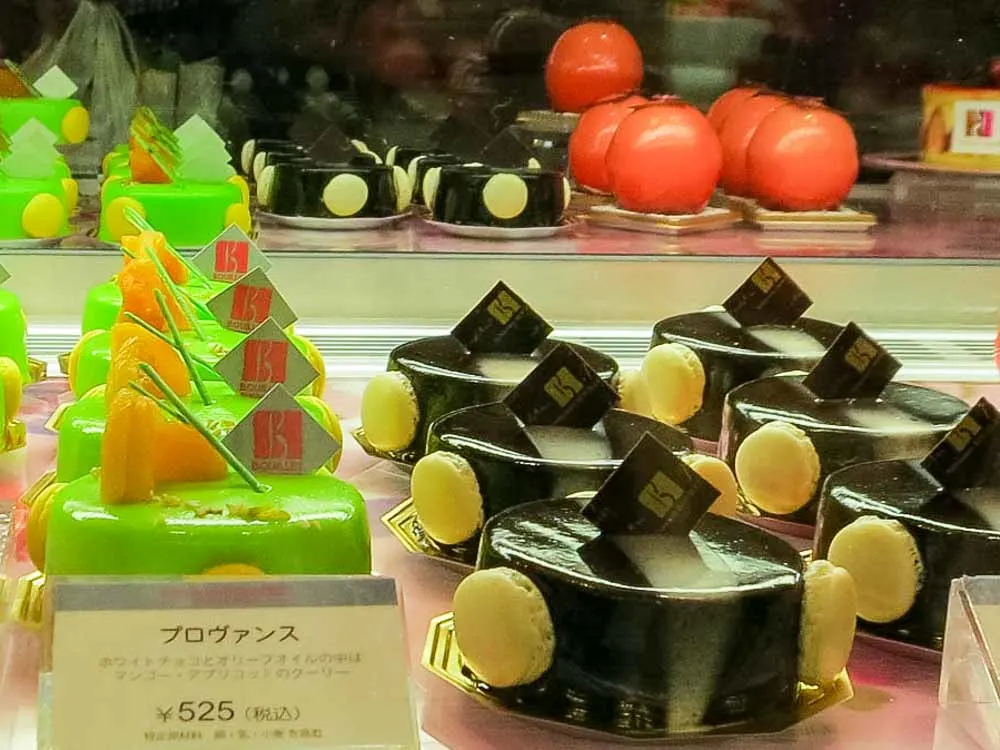
More recently, Japanese cuisine has been broadened further to include American burgers, Italian pasta and French pastries. Not messing around, Japanese chefs have mastered these western cuisines with a precision bordering on perfectionism. As as a result, Tokyo has more than 200 Michelin-starred restaurants including a dozen with three stars.
Fun Fact
Some Japanese are so obsessed with French culture (including French food) that they experience a condition called Paris Syndrome when France doesn’t live up to their lofty expectations.
Our History with Japanese Food
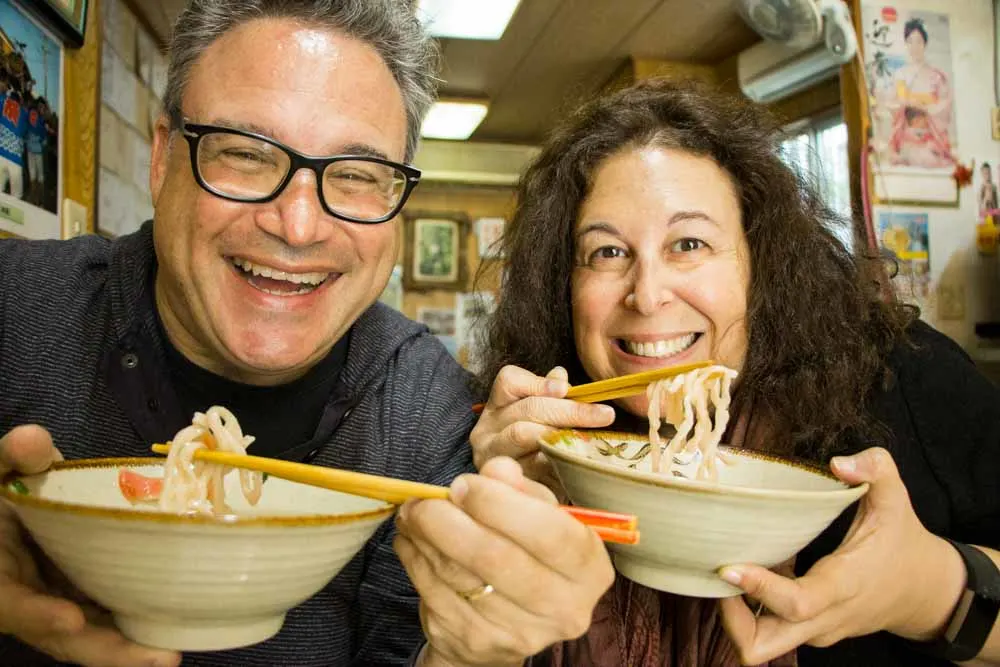
After eating typical Japanese food for years in America, we finally made it to Japan in 2013. What a revelation! We ate our way through both Tokyo and Kyoto at multiple izakayas, the Takashimaya department store, two famous markets (Nishiki and Tsukiji) and two Michelin starred restaurants (Florilege and Bird Land), but it wasn’t enough to quench our thirst for local Japanese food.
We returned to Japan in 2016 for a three-week stay in Osaka, a city aptly nicknamed Tenka no Daidokoro – Japan’s Kitchen. Staying in Japan’s most food-focused city for an extended time allowed us to dive deeply into the city’s street food culture and eat our weight in ramen, sushi and other famous Japanese food favorites.
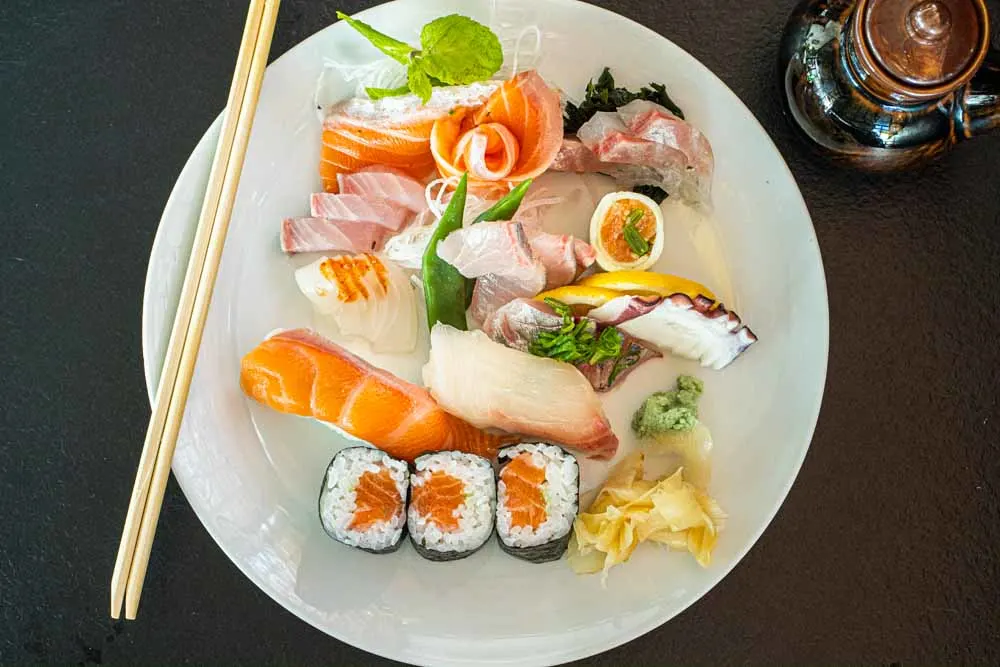
Returning a third time to Japan during an epic Asia cruise in 2018, we visited the port cities of Naha, Fukuoka and Nagasaki. After eating some of the best Japanese food in these disparate cities, we knew another return to the land of the rising sun was inevitable.
That fourth visit hasn’t happened… yet. Until it does, we can easily satisfy our Japanese food cravings in our home city of Lisbon and all over the world. But mark our words – we will return to Japan sooner than later to eat at the source. It’s inevitable.
What to Eat in Japan
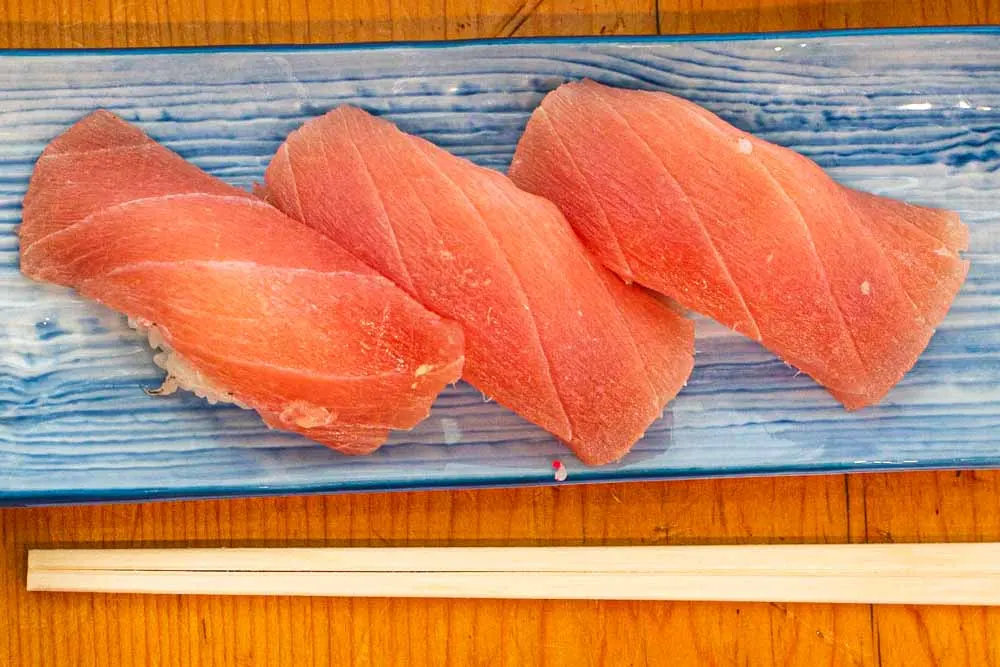
Our guide outlines 37 the Japanese foods and drinks that you can’t miss during your trip. Some are popular Japanese food favorites while others are more niche.
For ease of use, we’ve separated the guide into six categories:
We empathize with the temptation to only eat ramen and sushi when you travel to Japan for the first time. We love both of those dishes from Japan too. But don’t stop at these two popular Japanese foods since you’d miss out on dozens of other amazingly unique Japanese dishes.
Traditional Japanese Food
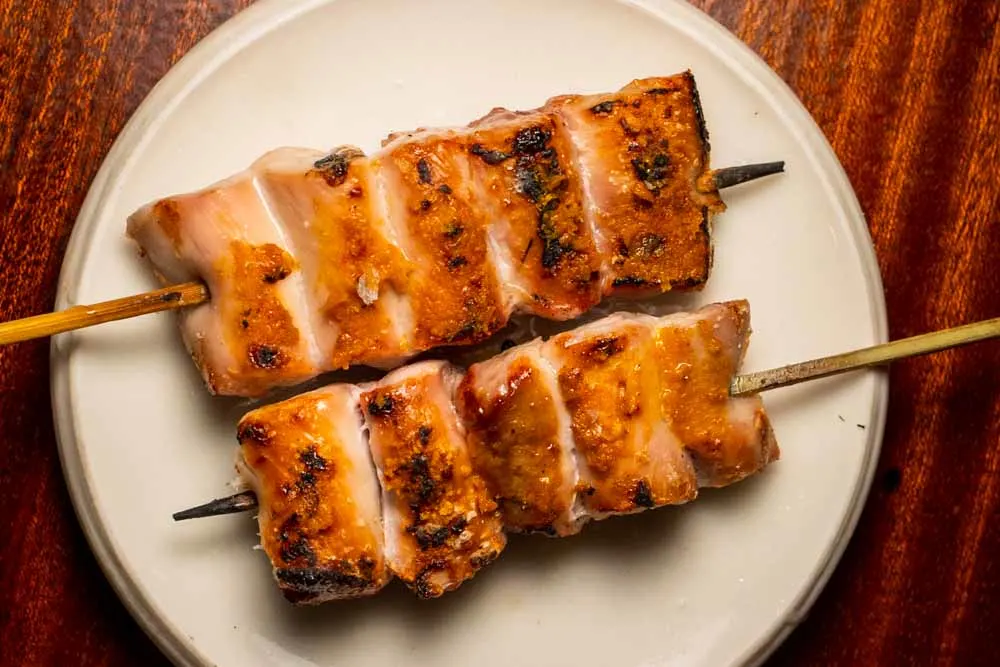
There’s no better place to start your Japanese food exploration than by eating traditional Japanese dishes. These are the dishes with popularity that extends beyond Japan.
As you consider foods to try in Japan, we recommend starting with ramen (one of our personal Japanese food favorites). Then you should eat each of the following dishes on your visit:
1. Ramen
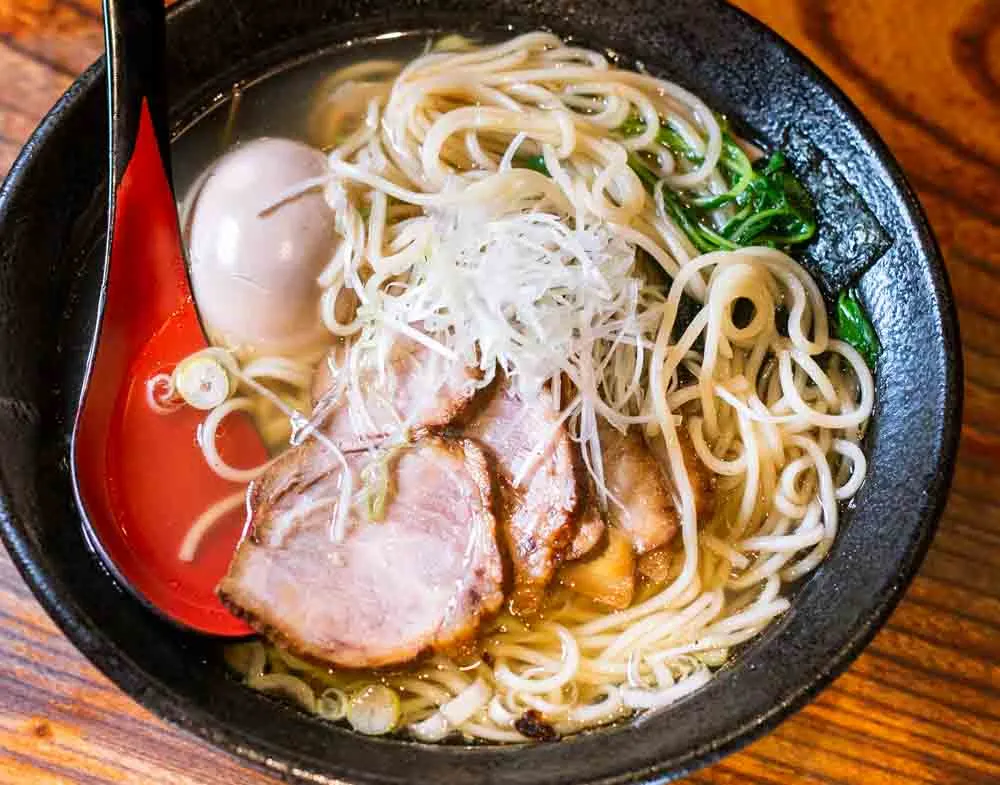
The Japanese didn’t invent ramen. That credit for this Japanese traditional food goes to the Chinese who originally created wheat lamien noodles, ramen’s inspiration. The Japanese, however, get credit for perfecting ramen before sharing this comforting noodle soup with the world.
For the uninitiated, typical bowls of ramen have savory broth, toothy wheat noodles, chāsū (pork), nori (seaweed), scallions and a softly boiled egg. Broth variations include miso, shoyo (soy sauce), shio (salt) and tonkotsu (pork bone). And this doesn’t contemplate regional variations like Hakata ramen in Fukuoka or Hokaido ramen in (you guessed it) Hokaido.
Discover more of the best soups in the world.
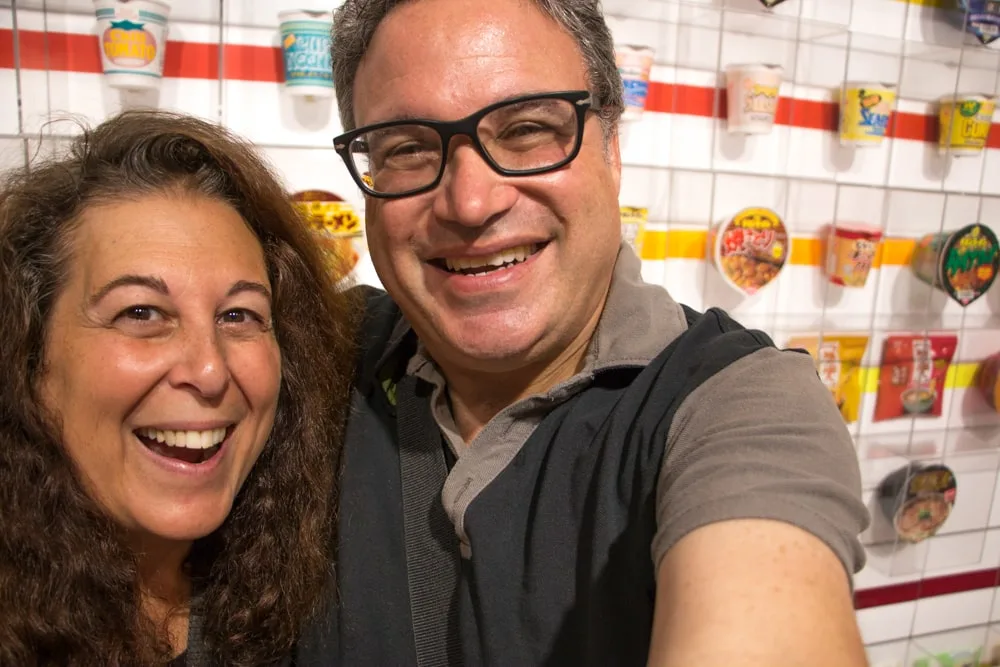
Our initial Japanese ramen experience at Ramen Street in Tokyo hooked us in but our ramen infatuation became a ramen obsession in Osaka. After slurping our first bowl at Ippudo at 2am soon after arriving, we proceeded to eat enough ramen to find our favorites. We became so obsessed that we visited the Instant Ramen Museum on the outskirts of the city during our visit.
We’ve since eaten ramen in cities like Budapest, Lisbon, New York and Paris. But there’s nothing like eating ramen in Japan as we illustrate in our soup-filled YouTube video.
Read about the best ramen in Osaka.
2. Sushi
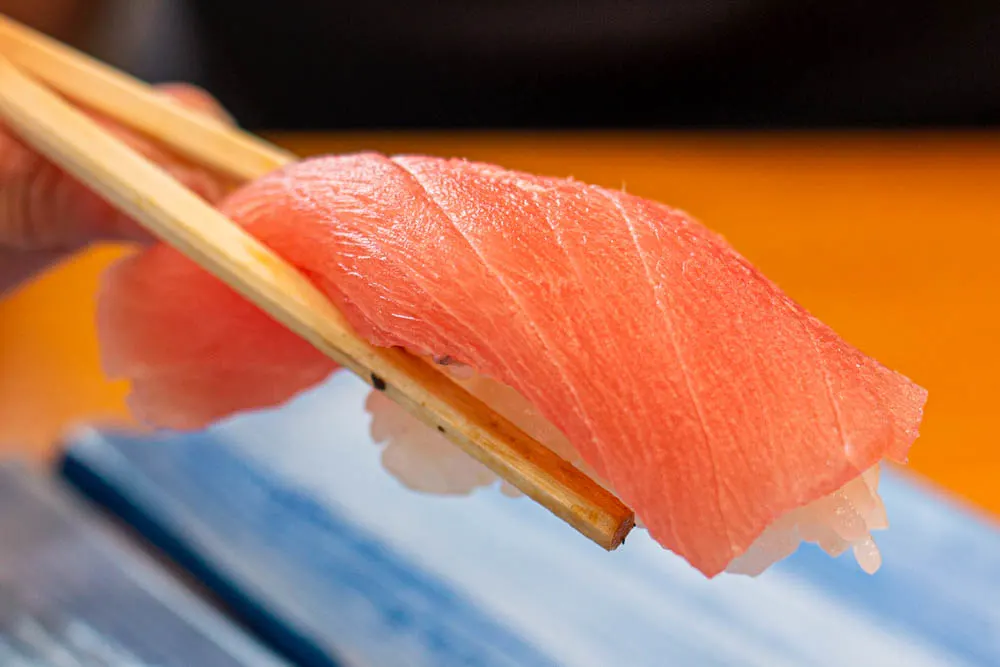
Sushi is simply sliced raw fish served atop a mound of steamed rice that’s been seasoned with vinegar. As we demonstrate in our YouTube video, it’s also proof that simple food is often the best food.
You won’t have to look hard to find this traditional food in Japan. Instead, it’s easy to find sushi at 7-11 convenience stores, markets and restaurants. On the low end, sushi is affordable and accessible to all. On the high end, as shown in the movie Jiro Dreams of Sushi, it’s a three-star, life-changing experience.
Watch the movie Jiro Dreams of Sushi on Amazon.
Adventurous food travelers will want to try conveyor belt sushi in Japan both for the quirky experience and the variety of raw fish. Popular options include ebi nigiri (shrimp) hamachi (yellowtail), ikura (salmon roe), maguro nigiri (tuna), sake nigiri (salmon), toro (tuna belly) and uni (sea urchin).
Pro Tip
Don’t add wasabi, soy sauce or ginger to sushi at any high end sushi counter in Japan. Doing so is considered an insult to chefs who like to remain in control of the flavor experience.
3. Sashimi
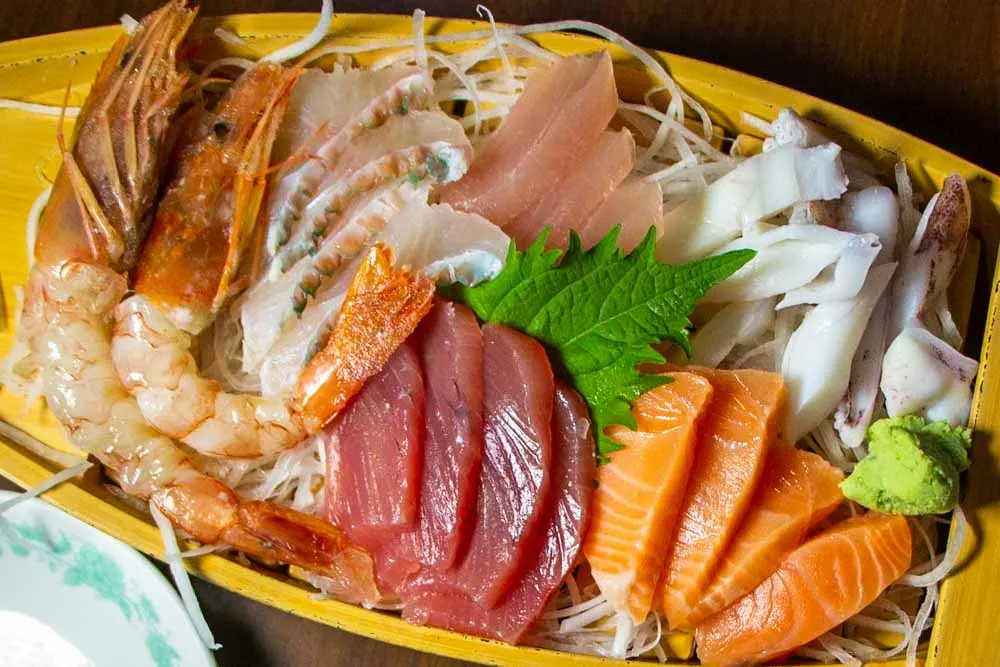
People outside of Japan tend to lump sushi and sashimi together. However, these two famous Japanese food favorites involving raw fish are not the same.
Unlike sushi, sashimi does NOT have any rice. The only ingredient in sashimi is thinly sliced raw fish. Typical garnishes include daikon slivers and shiso leaves.
While it’s possible to find sashimi made with meat or vegetables, the finest Japanese sashimi typically involves raw fish and seafood like ebi (shrimp), hamachi (yellowtail), eka (squid), maguro (tuna) and sake (salmon). More adventurous diners can also try aji (horse mackerel) and uni (sea urchin).
Pro Tip
Order a side dish of rice if want some carbs with your sashimi.
4. Unagi
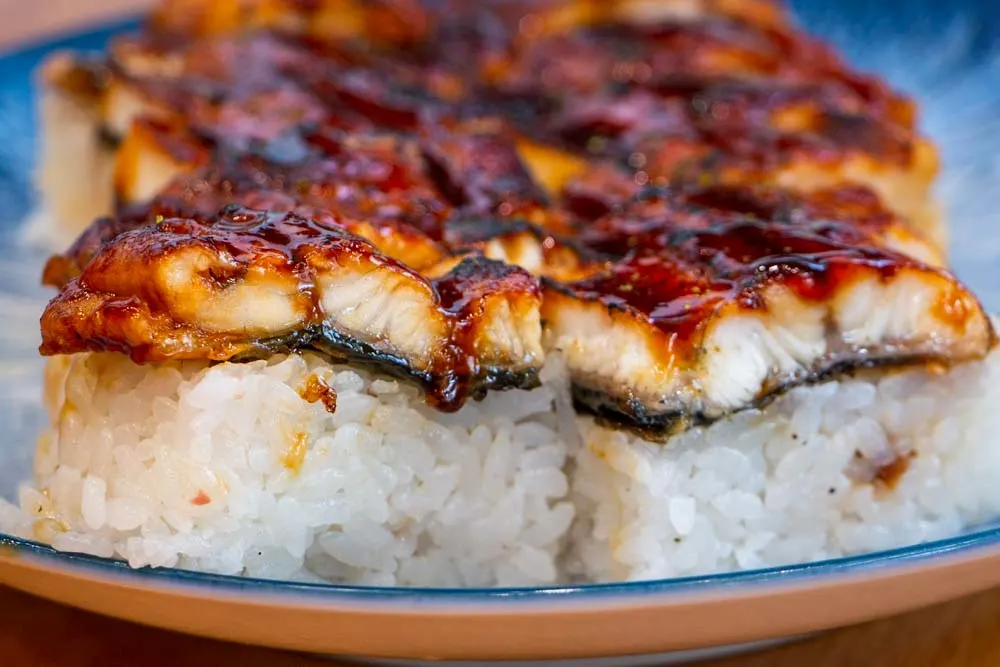
Eating unagi (freshwater eel) at a sushi restaurant is a great alternative for people who don’t eat raw fish. Japanese sushi chefs slather grilled eel fillets with a sweet and salty, umami-rich BBQ sauce before placing tasty eel morsels atop clumps of steamed rice.
Sure, there are other ways to eat unagi in Japan. One popular option is to eat unagi over a bowl of rice in a donburi dish called unadon. But for us, there’s no better way to eat unagi in Japan than the way we ate it in Osaka sushi bars – full of flavor and on top of rice.
Pro Tip
Although unagi is available throughout the year in Japan, freshwater eel is especially popular during the warm summer months.
5. Tempura
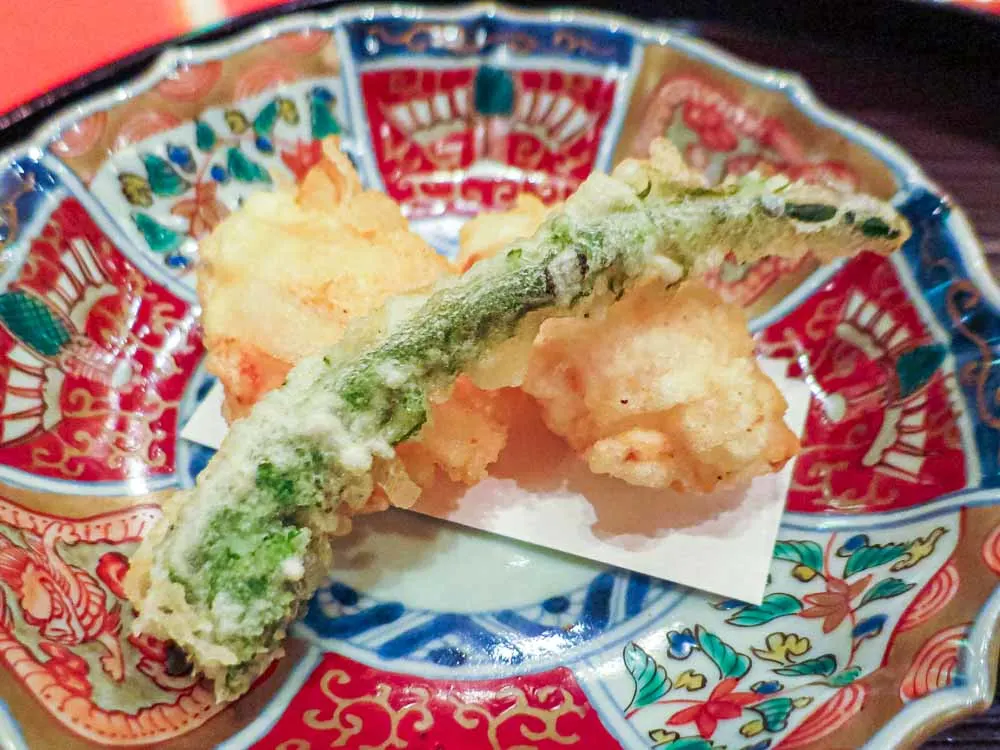
Leave your preconceptions about fried food behind when you order tempura during everyday Japanee meals as either a starter or main dish. Although tempura is deep fried, it doesn’t taste greasy and it’s not messy to eat.
Japanese chefs prepare tempura by precisely cutting ingredients like shrimp, shiitake mushrooms, lotus roots and shishito peppers before lightly coating them with batter and frying them in oil.
Most people dip the crispy, savory treats in ten-tsuyu dipping sauce. Another option is to sprinkle on salt before taking the first bite.
Fun Fact
The Japanese learned the art of tempura from Portuguese missionaries who traveled to Japan in the 16th century. The original Portuguese dish is called Peixinhos da Horta.
6. Yakitori
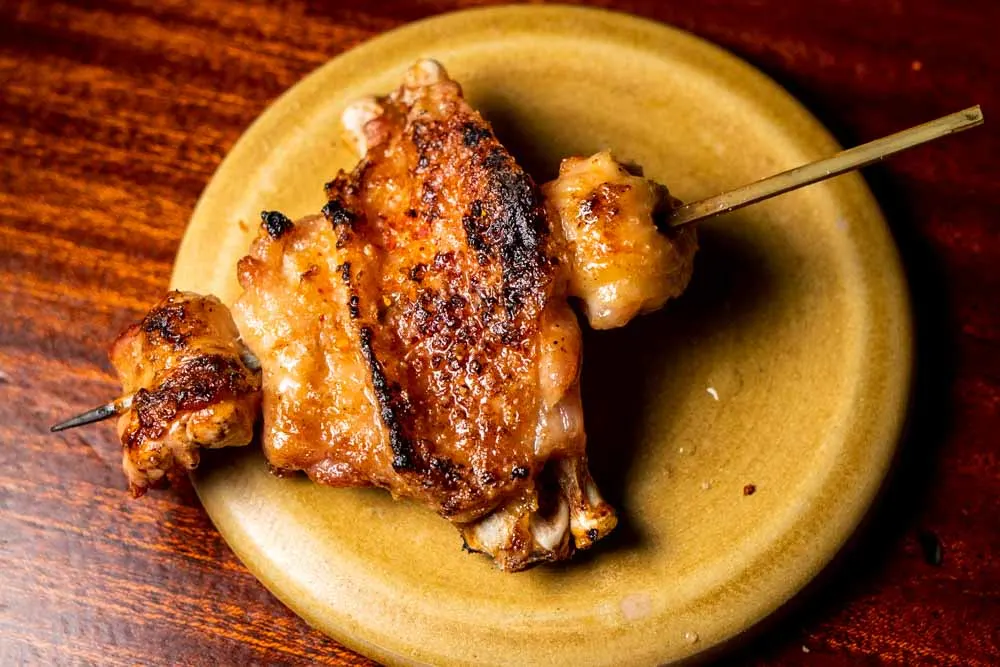
Yakitori became part of Japanese cuisine in the 19th century when street stalls starting grilling skewered chicken pieces over charcoal. Fast forward to the present and yakitori is now a a beloved traditional food of Japan and astaple at restaurants throughout the country.
Anthony Bourdain introduced Japanese yakitori to the western masses when he ate chicken skewers at Toriki in his Tokyo No Reservations episode. We later ate yakitori at Michelin-starred Bird Land located in a Ginza metro station across the hall from Sukiyabashi Jiro. Unlike Bourdain, we stuck with yakitori and skipped eating chicken sashimi during our meal. We ate some medium rare chicken during our meal instead.
Not limited to thighs and breasts, Japanese chefs grill skewered chicken hearts and cartilage, among other parts, over white binchotan charcoal to various levels of doneness. They then serve the skewers on simple small plates.
Pro Tip
Be like the Japanese and drink beer with your yakitori. It’s a winning combination.
7. Udon
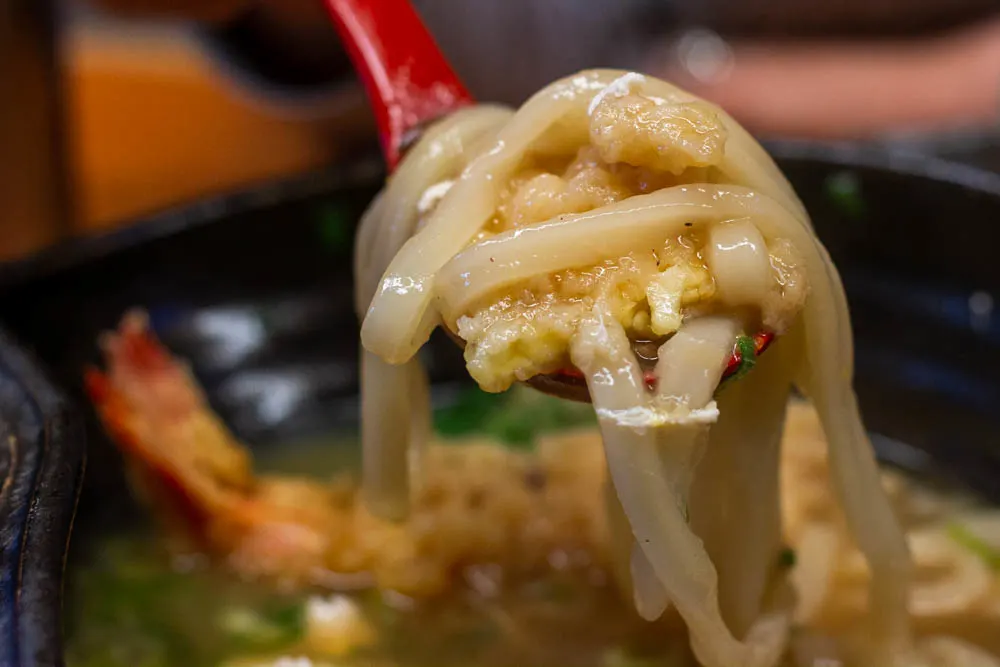
If you confuse udon with ramen, you’re not far off the mark. Both dishes feature wheat noodles originally introduced to Japan by China centuries ago. But make no mistake, ramen and udon are as different as they are similar.
For starters, udon noodles are thicker in size and whiter in appearance. They’re often served in a simple dashi broth, though other various iterations, both hot and cold, feature eggs, stewed meat, curry and even shrimp tempura.
While we ate udon for breakfast at a popular Osaka fish market stall, the Japanese eat udon at all hours of the day and night. It’s a comforting, versatile dish with as many potential ingredients and toppings as the imagination allows.
Pro Tip
Use chopsticks and a spoon when you slurp udon in Japan so that you don’t miss any bits or bites.
8. Soba
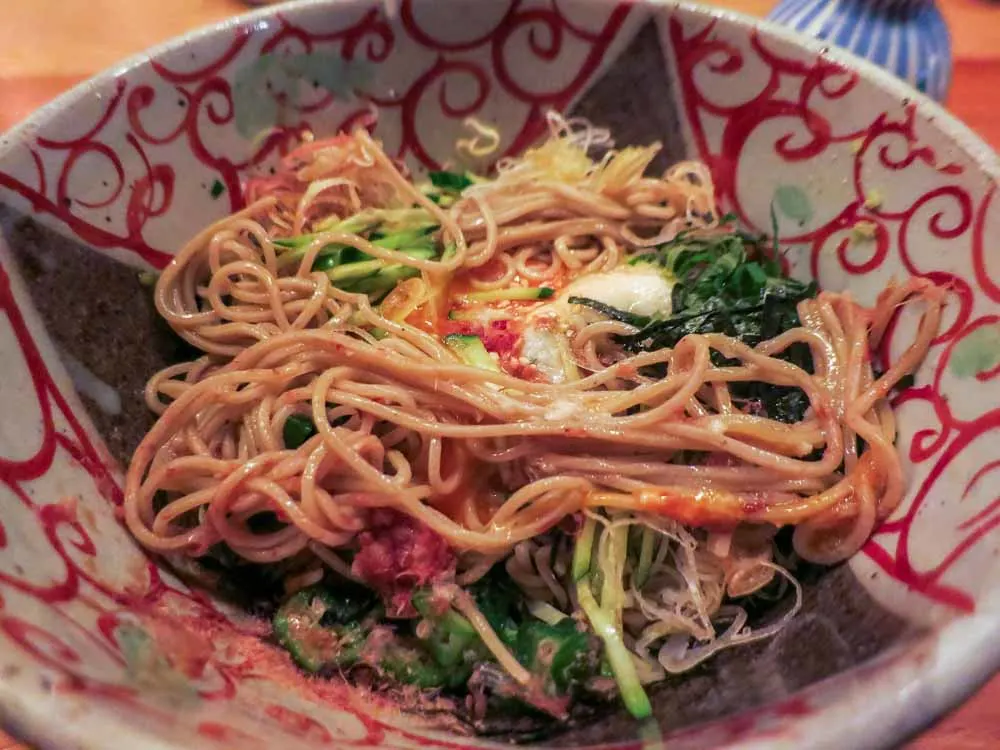
Soba literally translates to buckwheat and that’s exactly the type of noodle used in this dish. Made with buckwheat flour as advertised, soba noodles are both longer and thinner than ramen and udon noodles.
Japanese restaurants serve soba noodles both hot and chilled, often with tsuyu dipping sauce. Simultaneously earthy and nutty, soba proves that ramen and udon aren’t the only noodles worth eating in Japan.
Fun Fact
The Chinese introduced soba noodles to Japan. Are you noticing a trend yet???
9. Agedashi Dōfu
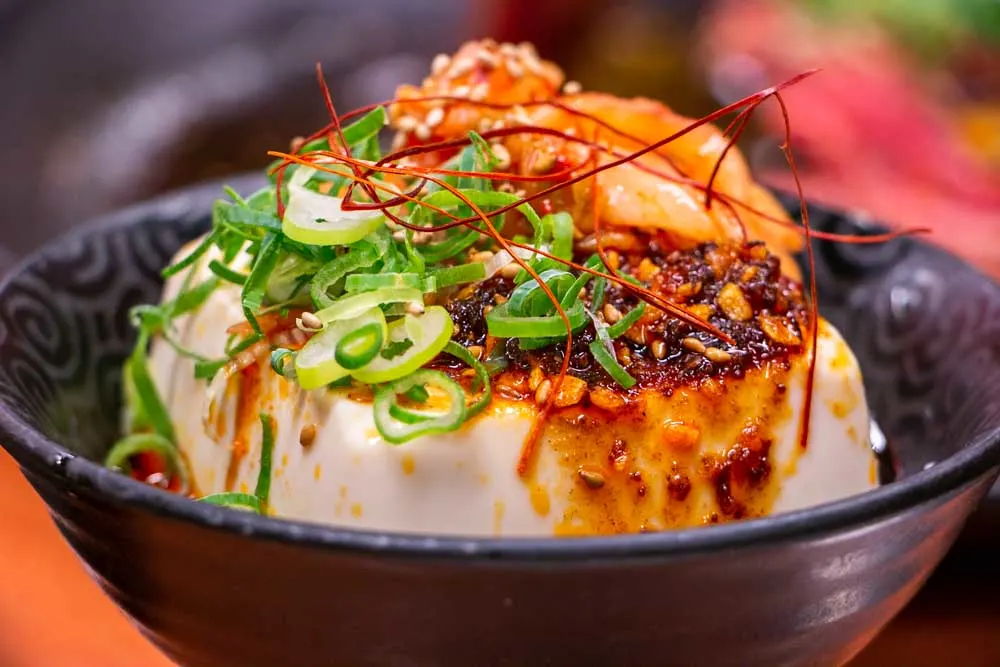
Agedashi dōfu lives up to a name that translates to fried tofu. But this dish is more than its name implies since Japanese chefs add touches like spring onions and dried bonito flakes as well as savory tentsuyu broth.
Both vegetarians and carnivores have been eating creamy, soft agedashi dōfu for centuries in Japan. The dish, usually listed in the appetizer section in Japanese menus, is now a staple across the country.
Fun Fact
Tentsuyu sauce is a popular Japanese dipping sauce made with dashi, mirin and soy sauce.
10. Japanese Curry
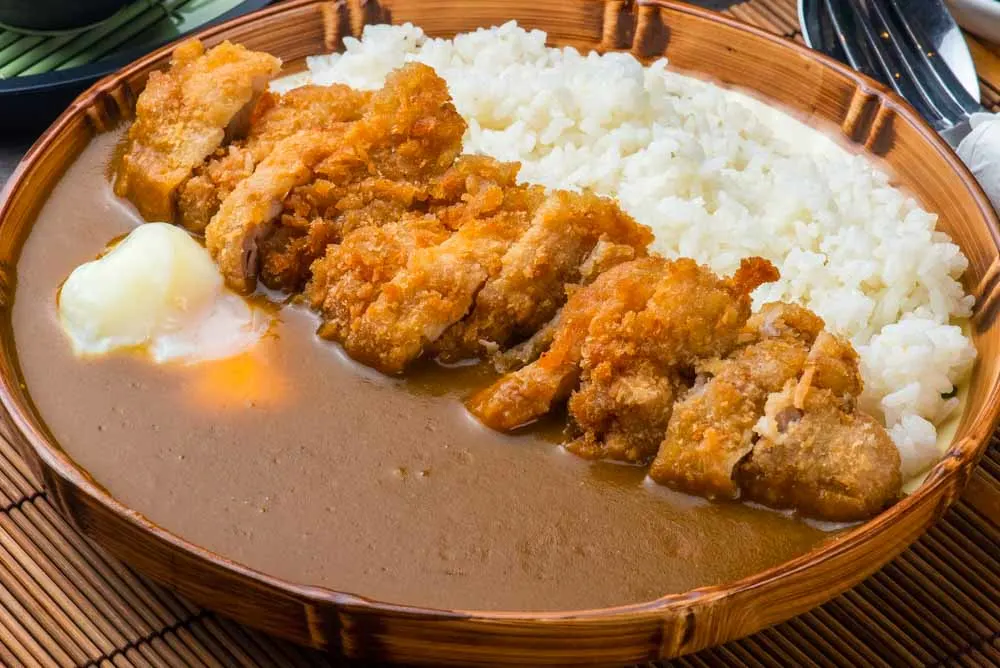
Most food travelers don’t associate curry with Japan. The dish has roots in India, a country almost 4,000 miles away. However, Japanese Curry is ridiculously popular in Japanese cities like Osaka and Tokyo.
History reveals that British traders introduced curry to the Japanese in the 19th century. The Japanese made the dish their own by creating curries with short-grain rice as well as local meats and vegetables.
After we tried katsu kare at a casual restaurant near our Osaka apartment, we returned multiple times to eat tasty Japanese Curry topped with fried tonkatsu pork. By adding sides of pickled vegetables and miso soup, we turned the cheap eats dish into a satisfying meal.
Pro Tip
Avoid spillage by eating Japanese curry with a spoon.
11. Wagyu Beef
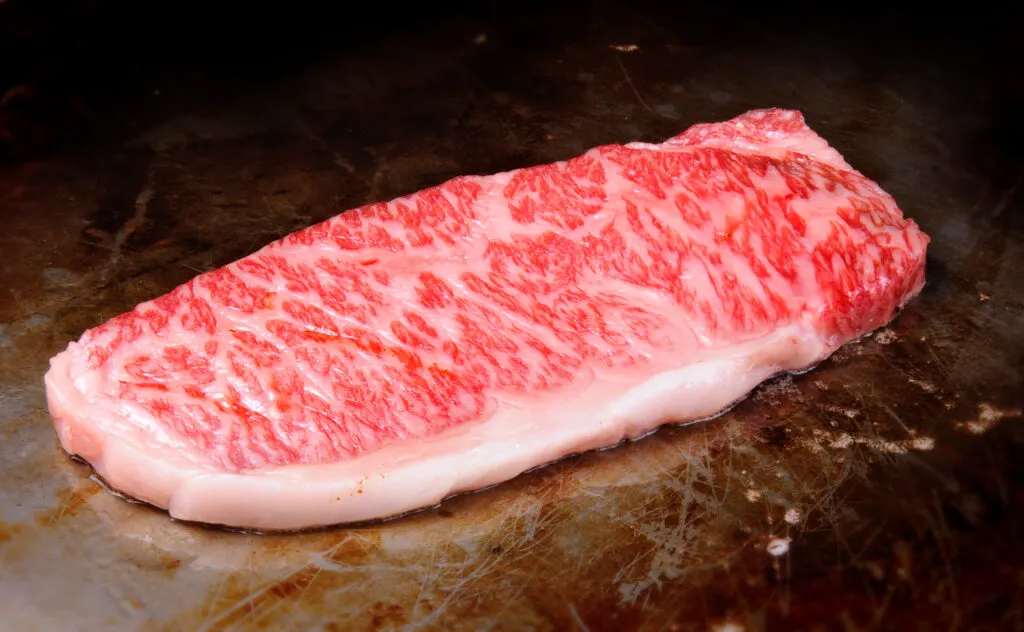
Coveted around the world for its fabulously fatty texture and umami-filled flavor, Wagyu beef is the meat to eat in Japan. And though Kobe beef produced in the Hyōgo prefecture, not far from Osaka, is the most famous Wagyu beef produced, there are all kinds and grades of excellent Wagyu throughout the country.
Marbling provides the fatty texture that distinguishes Wagyu beef from beef produced in other Asian countries and throughout Europe. Priced higher than other Japanese food favorites, this beef is a splurge to try and a pleasure to eat on its own or part of a shabu-shabu meal in Japan.
Pro Tip
Order Wagyu beef rare.This is NOT a meat meant to be burned to a crisp or cooked to well-done status.
12. Miso Soup
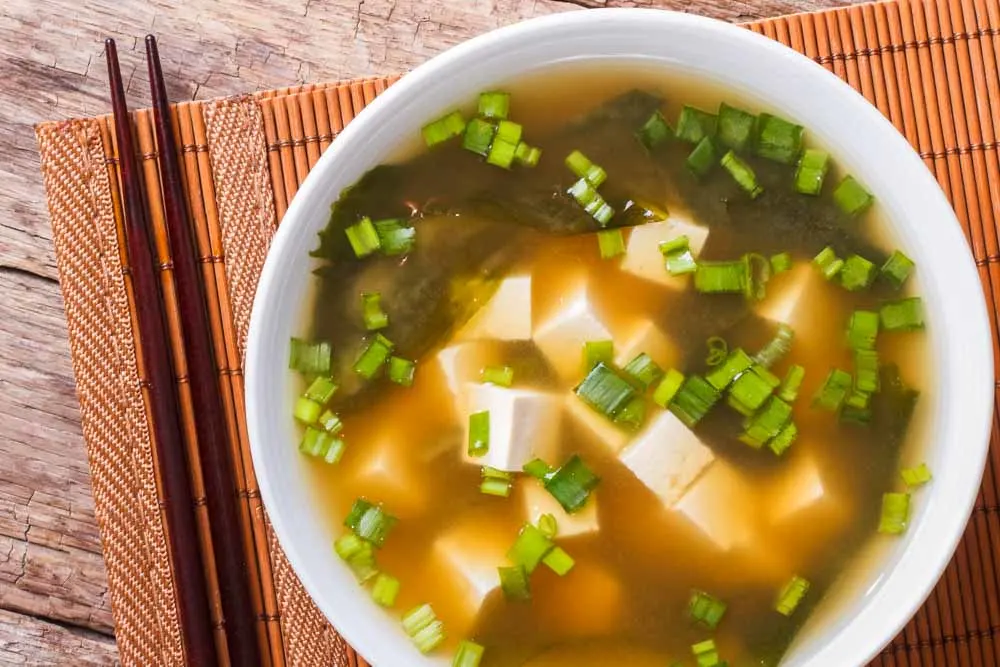
A combination of dashi stock and miso bean paste, miso soup is a popular starter at Japanese restaurants around the world. In Japan, it’s a key element of the daily diet.
While basic miso soup has tofu chunks and green onion slices, better versions add veggies and proteins to the mix. Our favorite miso soup in Tokyo was filled with baby cockles (clams), a briny addition that elevated the basic broth to something truly special.
Pro Tip
Don’t assume that miso soup is vegetarian. Ask before ordering if you have an aversion to eating fish products.
13. Chawanmushi
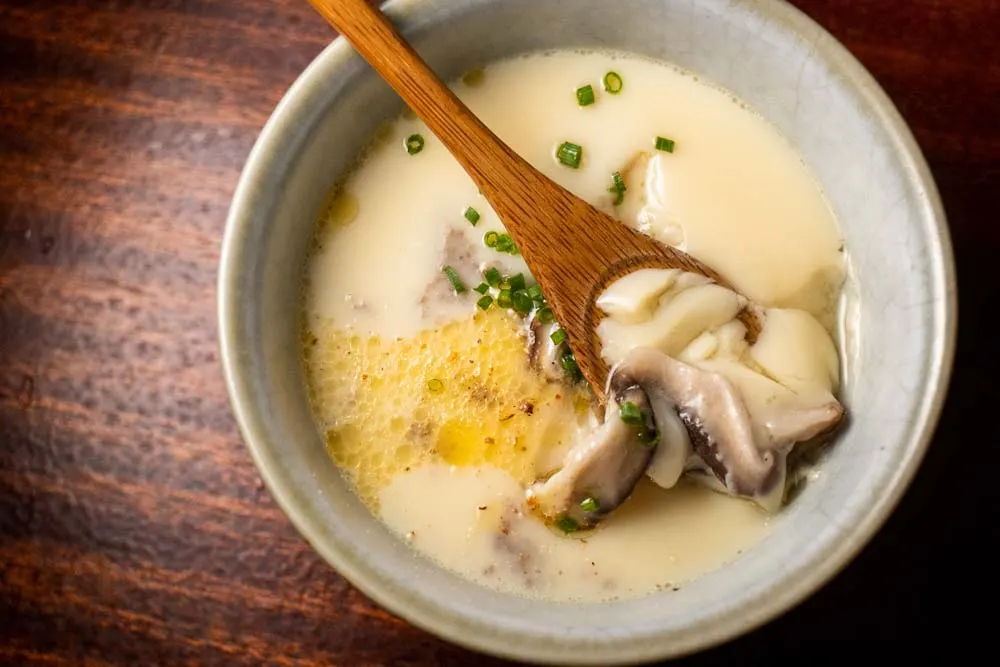
Custard fans won’t want to miss chawanmushi in Japan. Unlike desserts like Spanish flan and Portuguese pasteis de nata, this Japanese egg custard is more of a savory meal starter.
Beyond eggs, chawanmushi ingredients include dashi, mirin and soy sauce, the same three ingredients in tentsuyu sauce. Some Japanese chefs add bonus items like shiitake mushrooms and shrimp.
Pro Tip
Check off two items (chawanmushi and udon) from this list by ordering odamaki udon if you see on a Japanese menu.
14. Gyoza
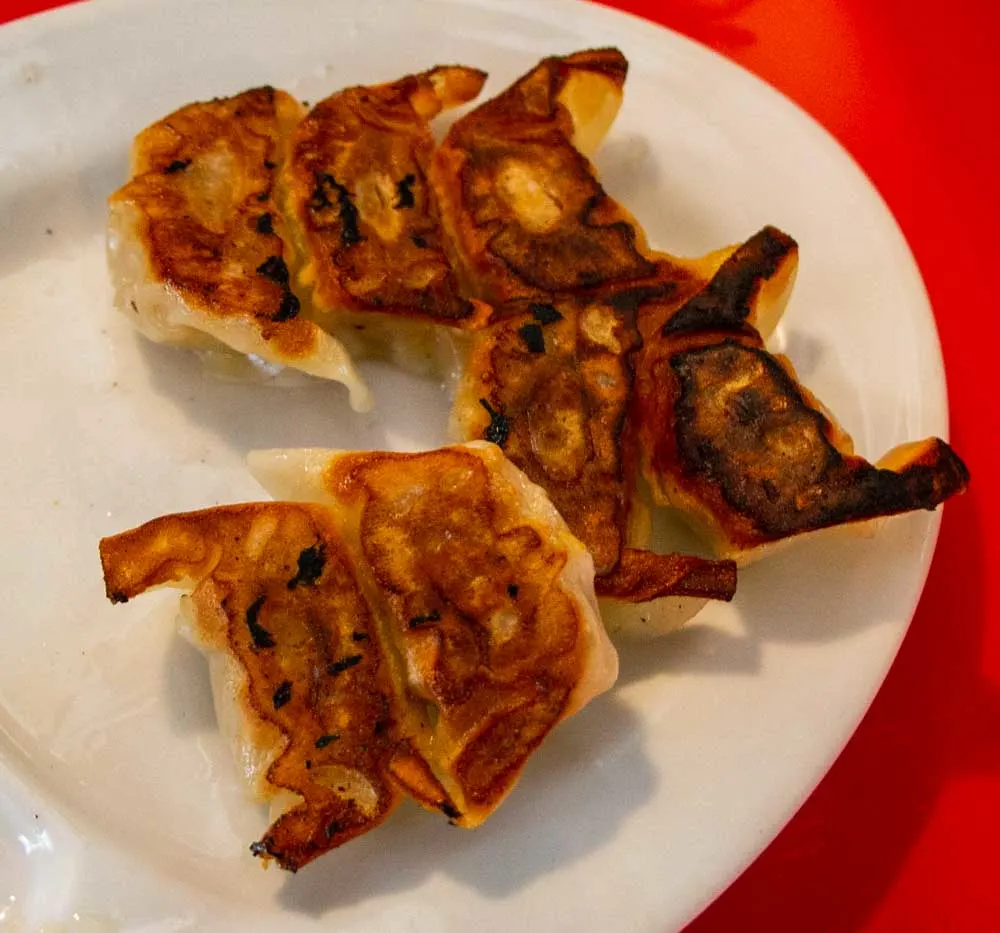
Gyoza is yet another Japanese dish with Chinese origins. But, unlike ramen and soba, this dish features dumplings instead of noodles.
Typically filled with a ground pork mixture, gyoza dumplings can be boiled or deep fried. However, pan frying is the most popular preparation with ramen shops and izakayas serving crispy pan fried dumplings across the country.
Fun Fact
Japanese gyoza were inspired by Chinese jiaozi dumplings.
Japanese Street Food
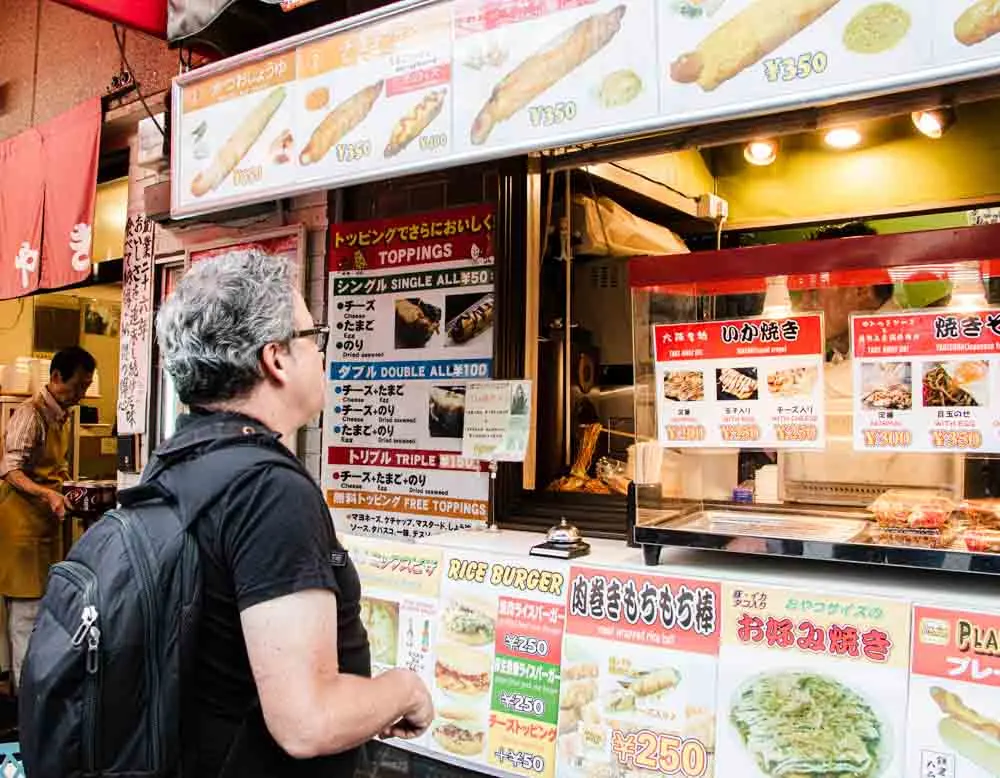
Snack food fans will have two problems in Japan. The first will be deciding among a myriad of fast food options at street stalls, convenience stores and markets. The second will be never wanting to leave.
We’ve got you covered with the first problem. The second problem is up to you because once you eat the following Japanese street foods, you’re going to be hooked. It’s inevitable.
15. Takoyaki
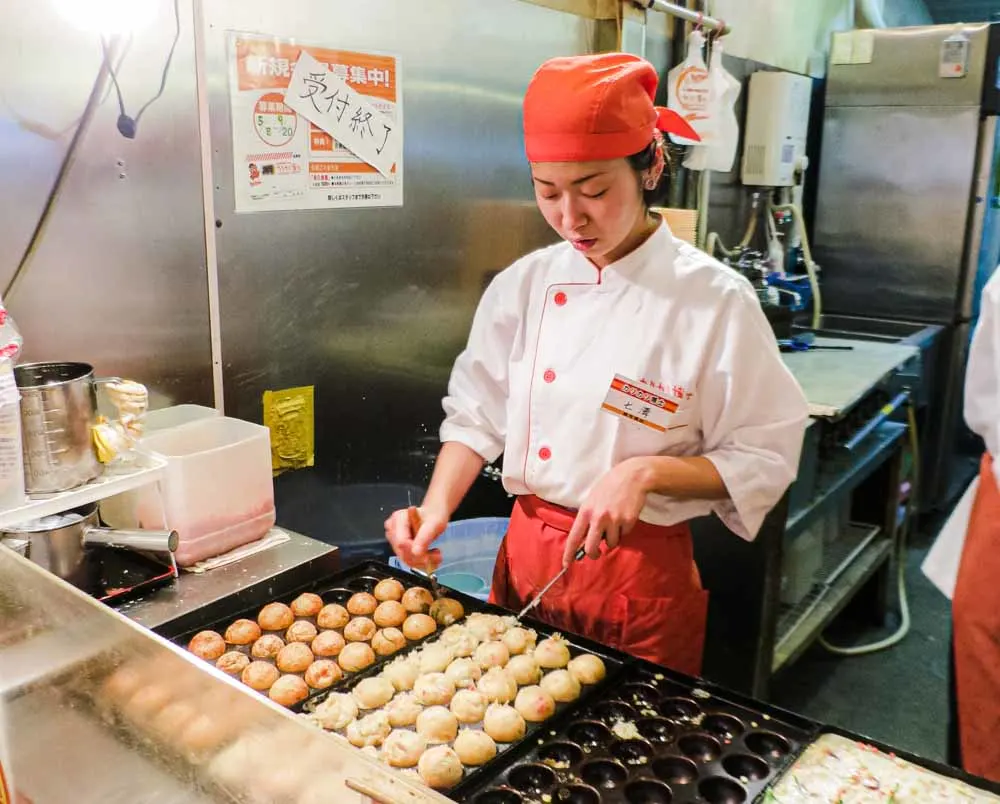
Without a doubt, Takoyaki belongs in the Japanese street food hall of fame.
Literally translating to ‘octopus balls’, takoyaki are little treats filled with octopus meat that vendors have been frying in special pans for almost a century. Originally a street food in Osaka, takoyaki are now available throughout Japan and in Asian cities like Hong Kong and Taipei.
We first tasted takoyaki in Hong Kong in 2009 before rediscovering the tasty octopus balls in Kyoto in 2013 and falling for them in Osaka in 2016. After we documented our infatuation in a YouTube video, we ate some more.
Part of the fun of eating takoyaki is to enjoy them piping hot, just off the grill. Pop them in your mouth and see if you’re ‘man (or woman) enough’ to endure the scalding burn.
Discover Kappabashi Street where you can buy special takoyaki pans.
16. Kushikatsu
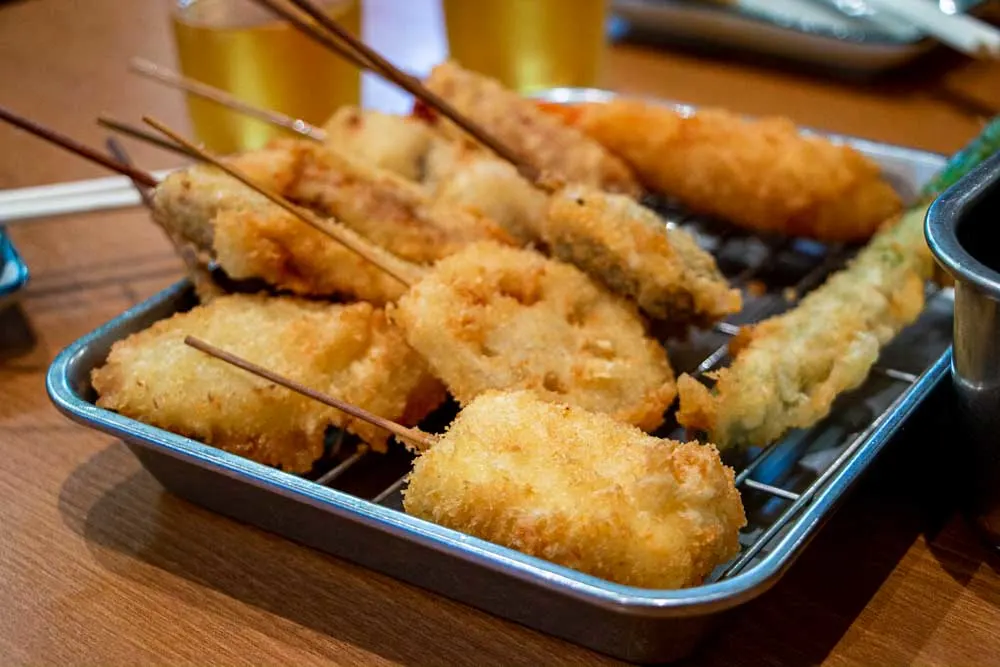
Why eat ‘meat on a stick’ at home when you can eat kushikatsu in Japan? Kushikatsu takes the street food concept to the next level by deep frying skewered meat cutlets, seafood and veggies like bamboo shoots, lotus roots and asparagus spears.
We first experienced kushikatsu in Osaka’s Shinsekai neighborhood after a languorous session at nearby hot tub heaven Spa World. Later, we learned that this neighborhood was where the concept of eating fried treats coated with panko batter originated.
Pro Tip
Don’t double dip your skewers in the dipping sauce when you eat kushikatsu. As in the TV show Seinfeld, this practice is a no-no in Japan.
17. Okonomiyaki
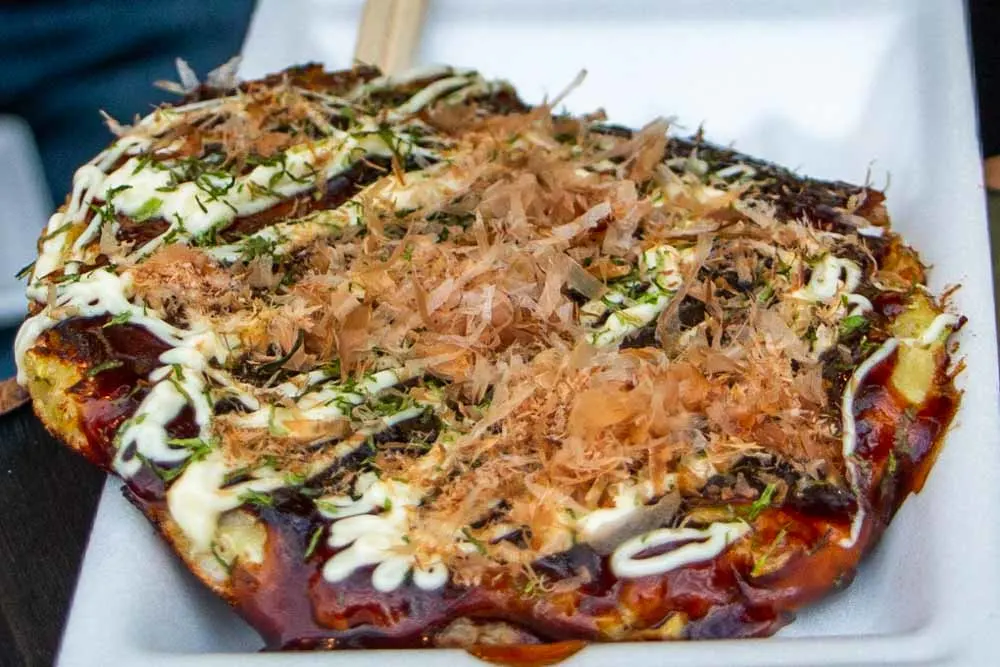
Japan’s Okonomiyaki is a pancake unlike any other we’ve encountered in the world. Made with wheat flour batter, julienned cabbage and bacon, this savory pancake typically has toppings like bonito flakes, seaweed flakes, mayonnaise and pickled ginger. A Worcestershire-like sauce completes the beautiful mess.
Not surprisingly, food historians trace the Okonomiyaki‘s origin to Osaka, Japan’s kitchen and a haven for junk food junkies. However, this ramped up Japanese omelette is popular throughout the country with each region adding tasty twists.
Pro Tip
Unless you want to eat your Okonomiyaki on the go, find a restaurant where you can grill it yourself at your table.
18. Katsu Sando
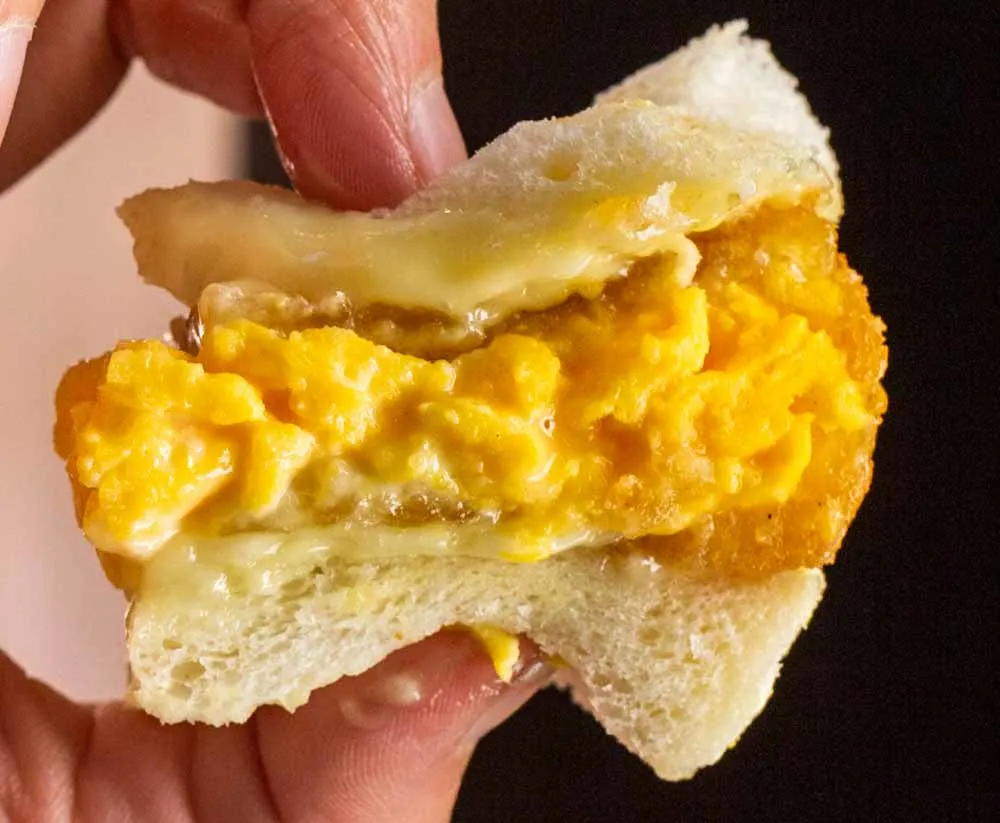
A katsu sando is a fried cutlet sandwich that’s often but not always made with pork. Other katsu sando varieties like chicken can be equally tasty while variations like fried wagyu elevate the katsu sando to luxury status. With this in mind, we took a special trip to a recommended tamago katsu sando at Kitashin Chisand in Osaka.
Read our Osaka Food Guide.
Eating a sandwich filled with breaded and fried egg salad was a unique experience and one worthy of that special trip. Trust the Japanese to add a twist to an American food staple and make it their own. We wonder when we’ll see a similar version back in the states. We’re sure we’ll eventually find one in a big city like New York or San Francisco. We just have to find it.
Pro Tip
Order a katsu sando if you crave a western sandwich that doesn’t involve beef or golden arches.
19. Onigiri
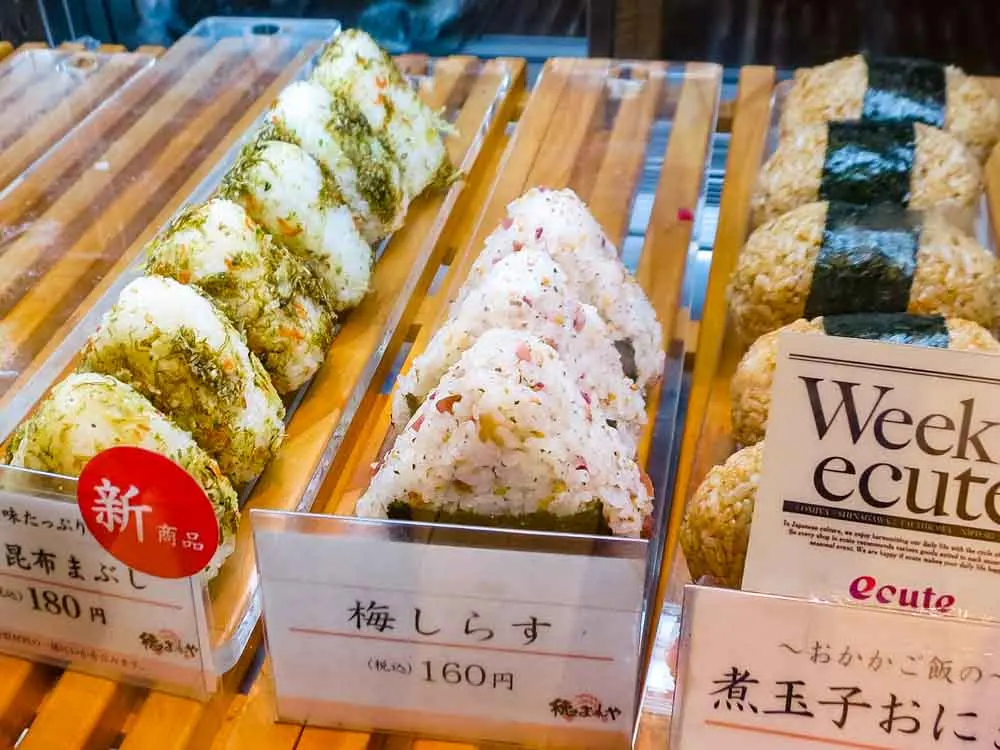
While sandwiches are a relatively new snack food in Japan, rice balls called onigiri have been popular with samurai soldiers and commuting citizens for two millennia. Formed in round, rectangular and triangular shapes, these rice balls are a convenience store staple often filled with tasty bits and occasionally wrapped in nori (seaweed).
We ate enough onigiri to find our favorites which typically involved raw tuna or salmon. Other popular fillings include pickled plums, tempura and bonito flakes.
Pro Tip
Try makng onigiri at home if you become addicted to the Japanese fast food favorite during your visit. No special equipment (except a nimble pair of hands) is required though a rice cooker will speed the process.
20. Tonkatsu
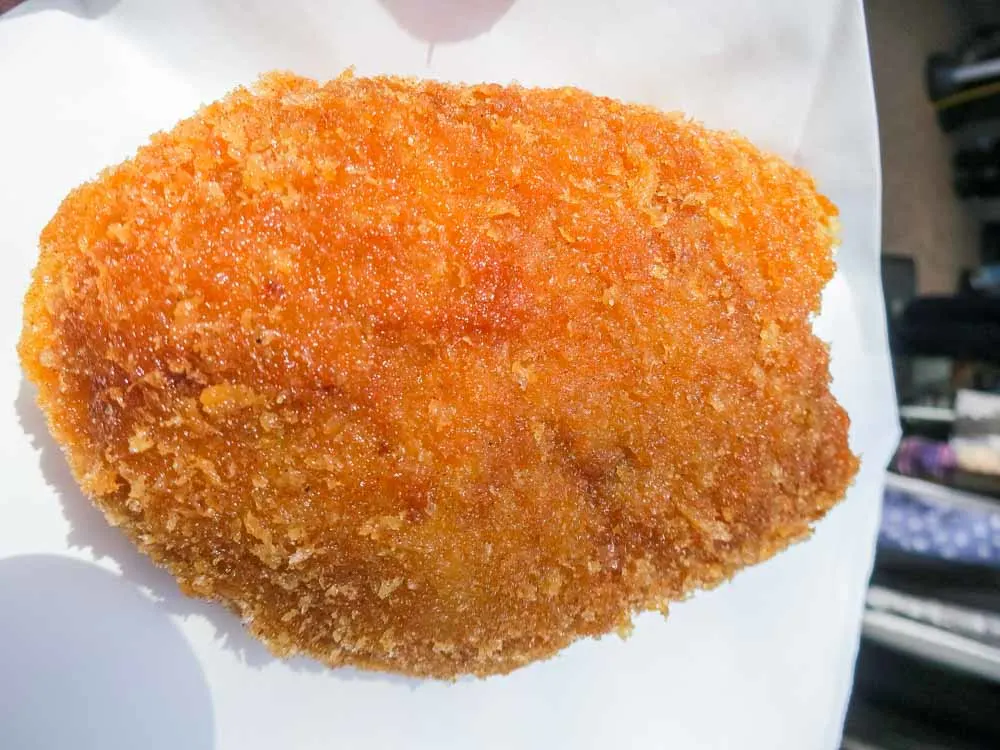
Pork fans won’t want to miss tonkatsu in Japan. Not only does this deep-fried pork cutlet represent the Japanese take on European schnitzel, it’s also a popular street food favorite that hits all the Japanese buttons.
The good news is that it’s easy to find tonkatsu at snack stands, ramen bars and curry shops. The better news is that Japanese breaded and fried pork cutlets taste good on their own, in soup or with rice. And by good, we mean great.
Pro Tip
Eat tonkatsu with sides of rice, sauce and shredded cabbage for a quintessential tonkatsu dining experience.
21. Tako Tamago
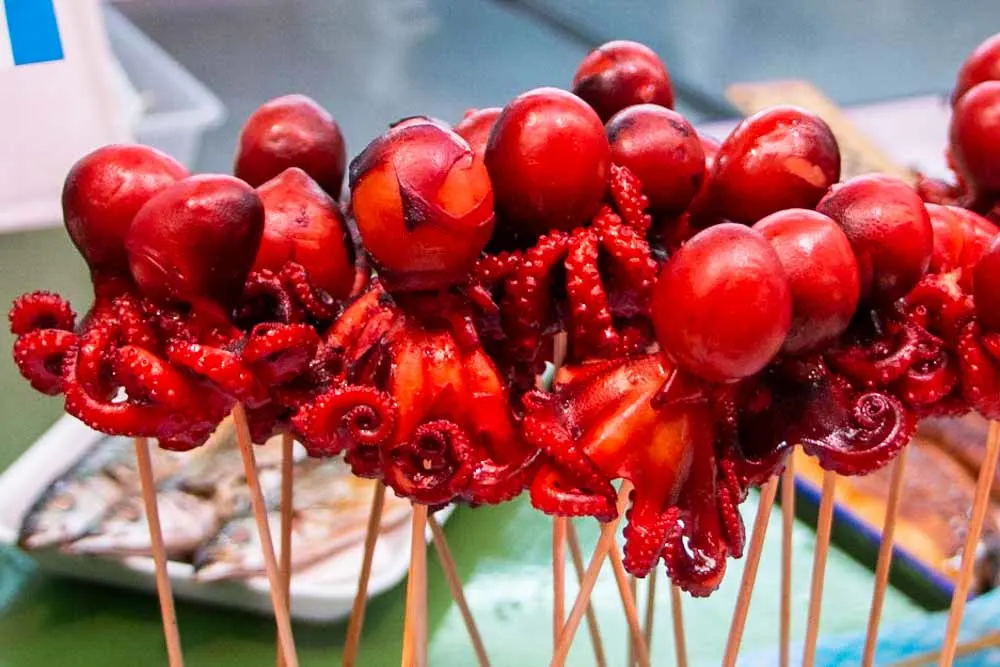
Not your typical lollipop, a tako tamago is a skewer topped with a glazed baby octopus, but not just any glazed baby octopus. These octopuses have boiled quail eggs stuffed inside their heads.
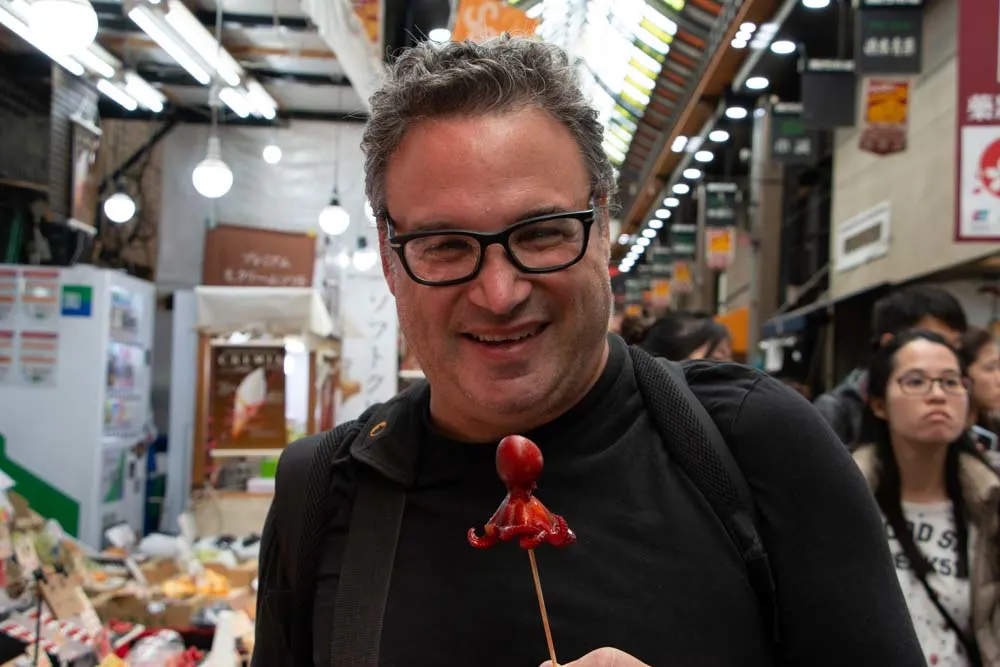
When we first encountered a tako tamago stand at the Nishiki Market in Kyoto, of course we had to taste this unique skewer. We enjoyed the slightly sweet, chewy snack so much we ate a second when we encountered another tako tamago stand at the Kuromon Market in Osaka.
Pro Tip
Don’t be deterred by the tako tamago‘s strange appearance. It’s a tasty snack. Just be sure to take a photo before you eat it.
22. Taiyaki
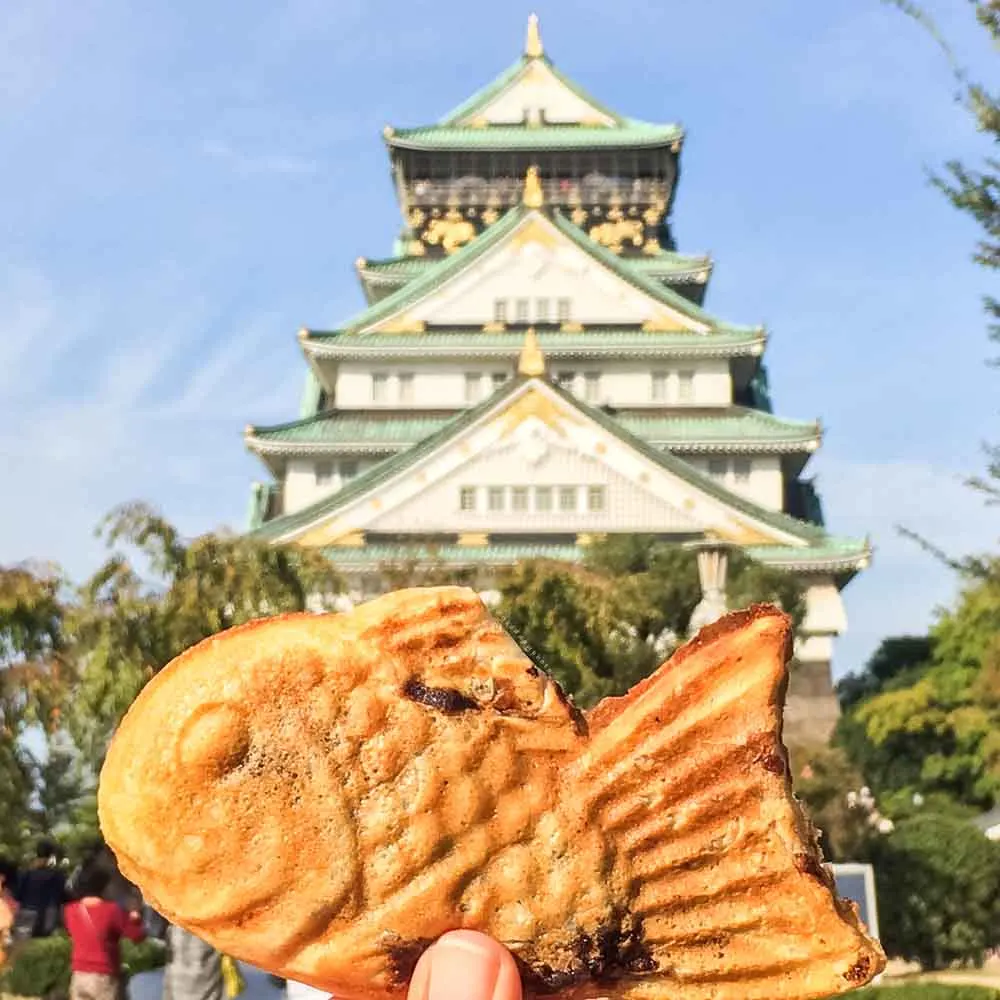
Despite its shape and name, a typical taiyaki doesn’t taste fishy. The irony is palpable since the word taiyaki literally translates to ‘baked sea bream’ and it’s shaped like a lucky tai fish.
Another irony is that the taiyaki is isn’t savory like the other Japanese street food featured in this guide. Instead, the fish-shaped cake has sweet fillings like red bean paste, sweet potato paste, chocolate and custard.
Consider it a lucky day if you see a taiyaki stand. It’s a fun treat and, who knows, maybe eating one will bring you good fortune.
Fun Fact
Unlike most Japanese snack food, the taiyaki hails from Tokyo instead of Osaka.
Unique Japanese Food Experiences
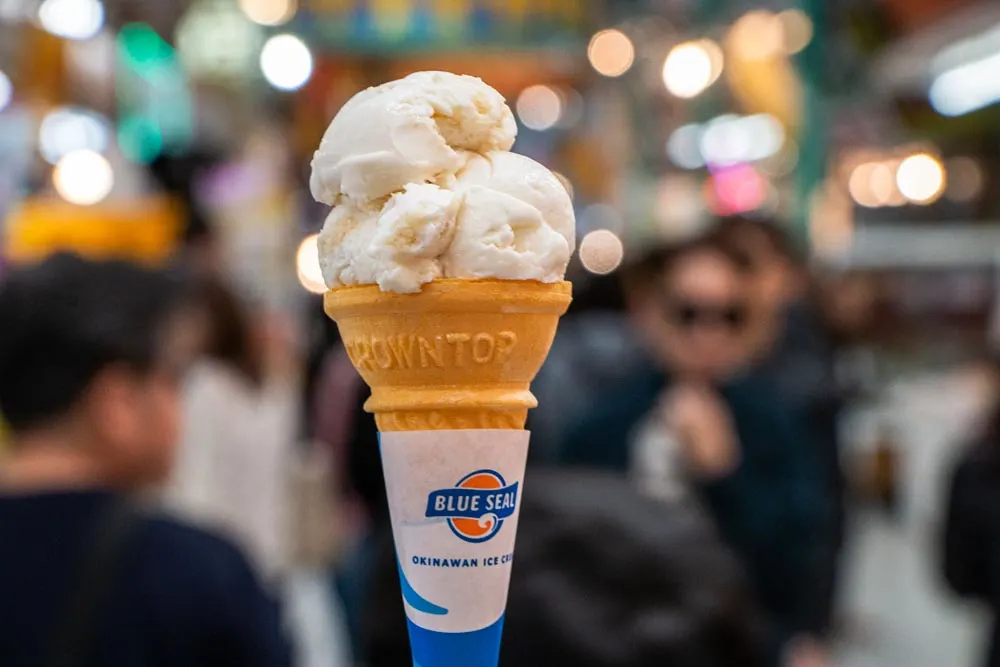
While most Japanese dishes are available across the country, some are best eaten in the region where they were created. Be sure to try the following two dishes if your travels take you to Fukuoka and Okinawa:
23. Hakata Ramen
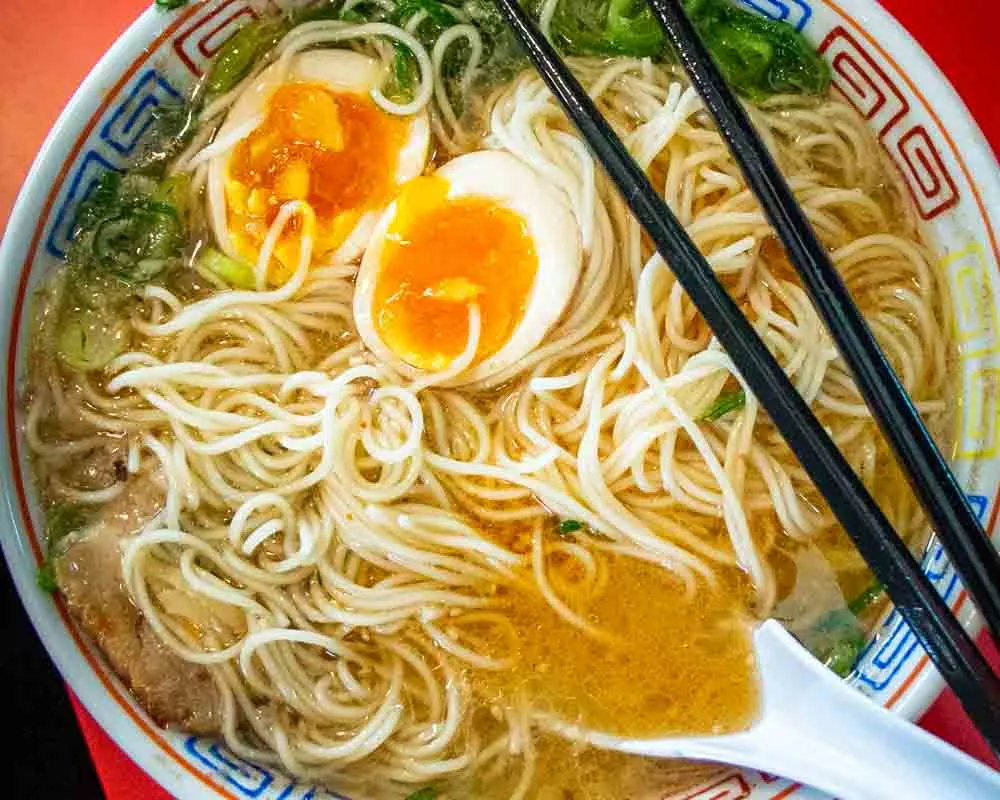
Although it’s easy to eat Hakata ramen throughout Japan, there’s something special about slurping a bowl in the coastal city of Fukuoka where it was invented. Originally sold to local fishermen, Hakata ramen is now an international dish served all over the world in ramen shops from New York to London to Bangkok.
Starting with flavorful pork bone broth, Hakata ramen has thin noodles that could be quickly prepared for those original fishing customers. Modern day customers can order kaedama (extra noodles) for a nominal charge.
Pro Tip
Since toppings give Hakata ramen some extra zip, add beni shoga (pickled ginger) and karashi takana (pickled mustard greens) to your bowl if they’re available .
24. Okinawa Soba
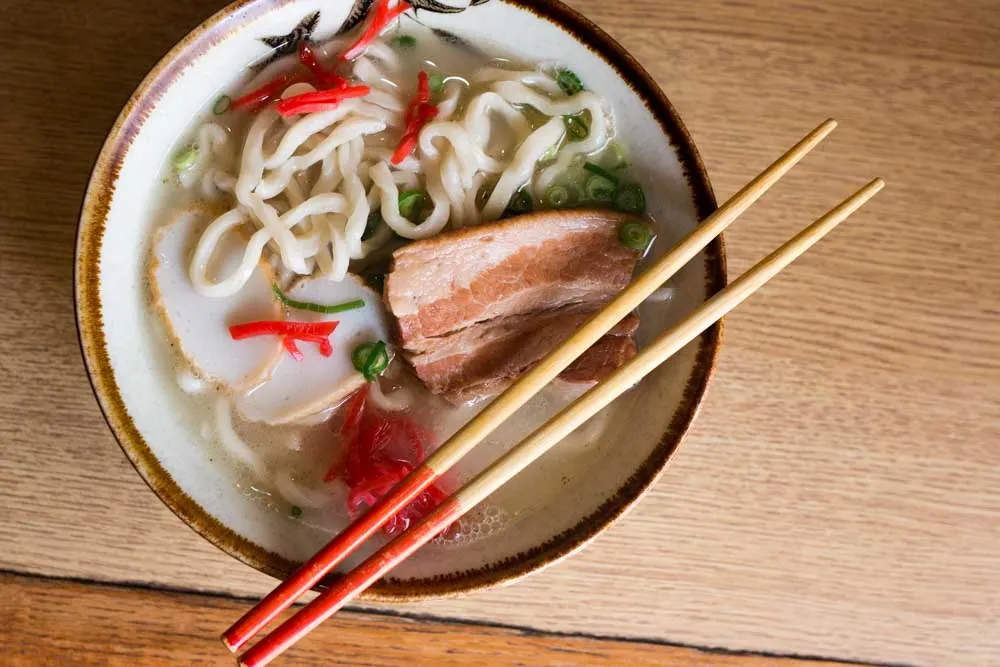
Okinawa soba is an anomaly. Even though soba translates to ‘buckwheat’, this regional soup features wheat noodles.
Okinawa soba is also delicious as we experienced during our visit to Naha. Thick homemade wheat noodles reminded us of udon noodles while the broth reminded us of ramen. Ingredients like pork belly, fish cakes, sliced scallions and pickled ginger made the dish its own colorful, tasty thing.
Pro Tip
Order Okinawa soba with extra ribs or stewed pig trotters if you’re feeling adventurous.
Unique Japanese Meal Experiences
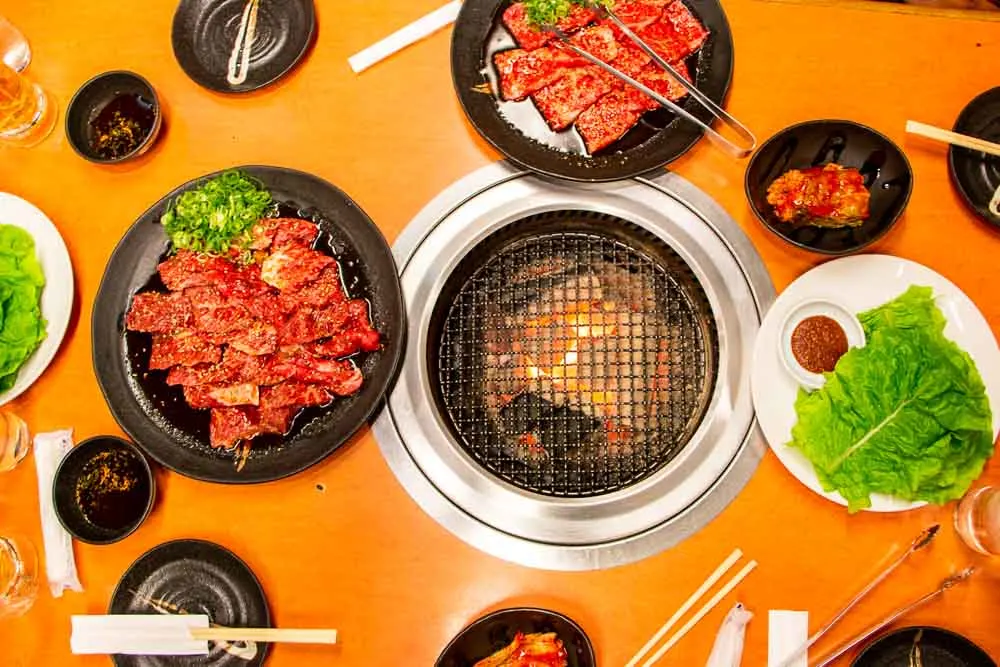
Part of the fun of eating in Japan is trying new dining experiences. We recommend that you plan ahead and participate in one or more of the following Japanese meals:
25. Yakiniku
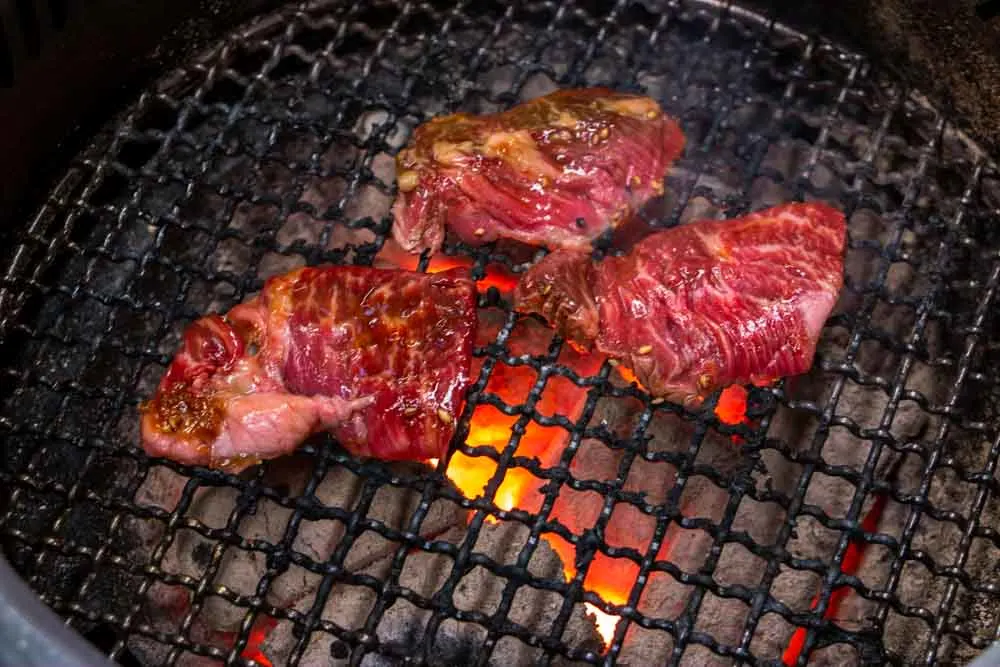
Not surprising based on its name that literally translates to ‘grilled meat’, a yakiniku dinner involves grilling meat on a tableside griddle. If it sounds familiar, that’s no coincidence. This Japanese style of eating was inspired by Korean BBQ restaurants located in Seoul and Busan.
Rolling up our sleeves, we joined two friends at an Osaka restaurant for a yakiniku dinner filled with freshly grilled Wagyu steak and sides like Japanese agedashi dōfu and Korean kimchi. Not only did we eat well, but we also had a lot of fun.
Pro Tip
Check the menu before you place your order. Our lettuce was oddly expensive. While we enjoyed making lettuce wraps, the price on the bill wasn’t a pleasant surprise..
26. Izakaya
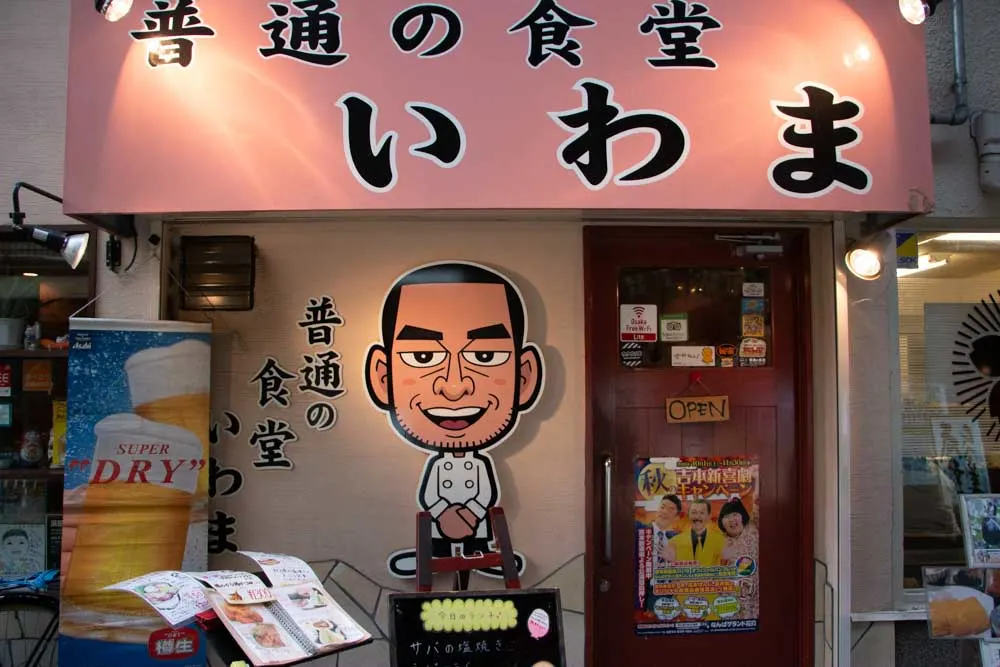
The word izakaya loosely translates to ‘tavern’, ‘pub’ and ‘bar’… and that’s exactly what you should expect when you visit an izakaya in Japan. This type of restaurant is casual with a friendly vibe. In many ways, izakayas are similar to diners prevalent on the American east coast but with real Japanese food on the menu instead of meatloaf and club sandwiches.
We like to order a range of small plates when we eat at Japanese izakayas. Some of our favorites dishes include yakitori, tamagoyaki (egg omelettes), kara-age (fried chicken) and fried potatoes. If you’re craving Japanese comfort food, a neighborhood izakaya will surely be your happy place.
Pro Tip
Plan to drink biiru (beer) with your izakaya meal. Whether you order it in a bottle or from the tap is up to you.
27. Kaiseki
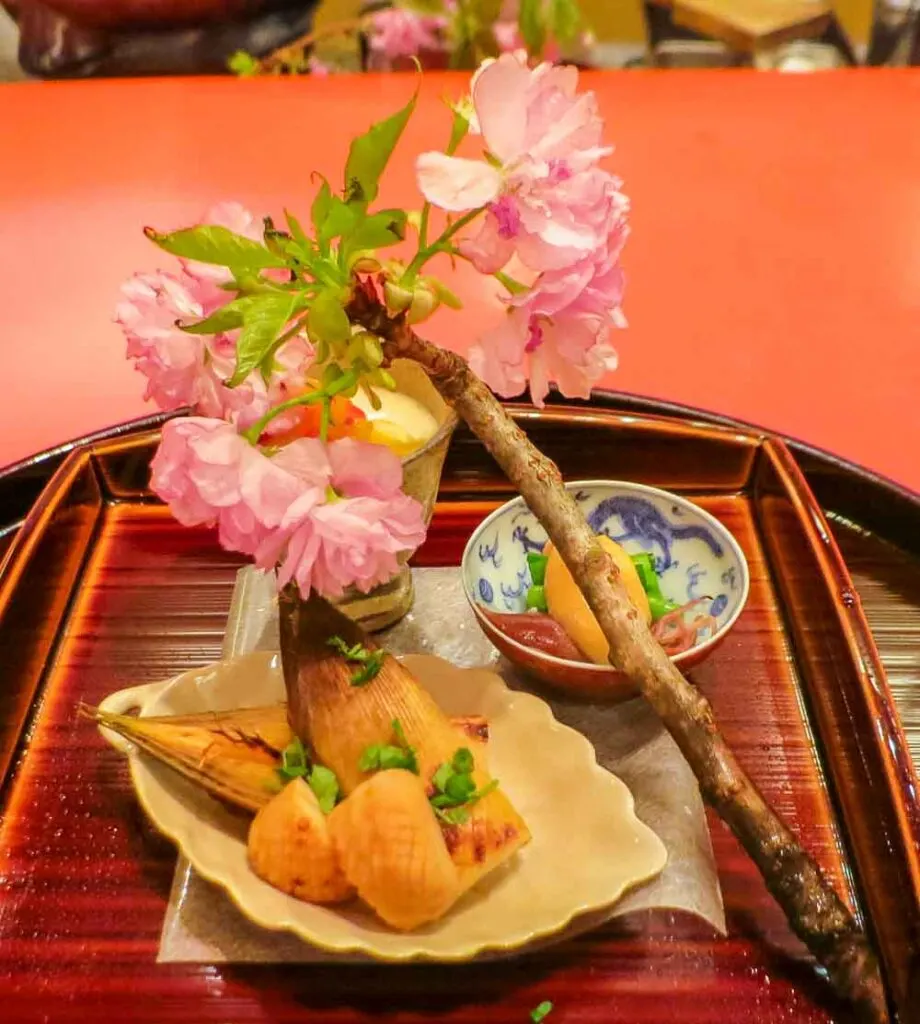
A kaiseki meal is the ultimate way to experience food in Japan. Typically spread over a few hours, this traditional Japanese meal pleases all five senses with each detail choreographed in advance. Although kaiseki meals follow a strict traditional structure, the experience is utterly relaxing for food travelers who have the means to splurge.
We took the culinary plunge in Kyoto, the epicenter for kaiseki dining. Our multi-course kaiseki meal included nine pretty plates topped with seasonal ingredients cooked to perfection. The chef was so attuned to details that he even garnished one of our plates with a freshly plucked sakura (cherry blossom) branch.
Pro Tip
Indulge in a kaiseki meal when you stay at a ryokan (traditional Japanese inn) in Japan. Otherwise, make a special dinner reservation at a restaurant like we did.
28. Shabu-Shabu
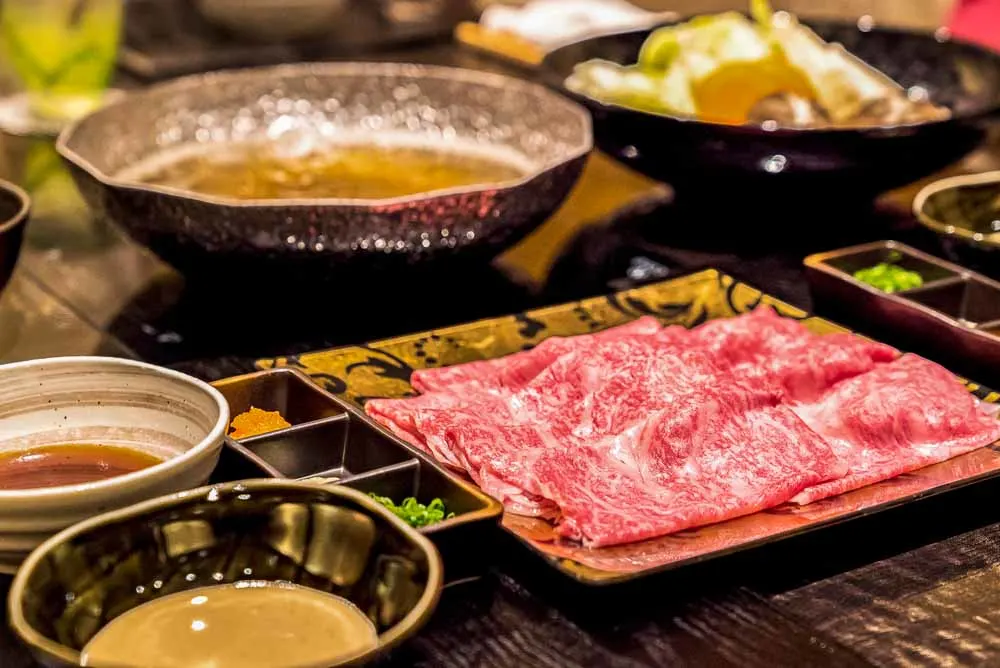
Evoking the sound of meat cooking in a pot of hot broth, an interactive shabu-shabu dinner is a fun way to spend an evening in Japan. While the shabu-shabu sounds comes from swishing chopsticks in a big pot, the fun comes from cooking and eating food at the same spot.
Buy a nabe pot on Amazon and make shabu-shabu at home.
Typical shabu-shabu food includes thinly sliced meats like chicken, pork, tofu and seafood as well as veggies like cabbage, onions and mushrooms. Cooking these foods in hot broth and dipping them in savory sauces is all part of the process. Eating them is the tasty reward during this traditional Japanese dinner experience.
Fun Fact
Like many aspects of Japanese cuisine, shabu-shabu was inspired by China and born in Osaka. In this case, the inspiration came from Chinese hot pot popular in cities like Chengdu and Chongqing.
Japanese Desserts

Desserts are rarely boring in Japan, a country where some sweet treats have histories that span the centuries. While it’s fun to explore wagashi (traditional Japanese desserts), it’s equally fun to sample modern Japanese sweet dishes.
We ate a lot of desserts in a half dozen Japanese cities. These are our favorites and the six you shouldn’t miss:
29. Candy
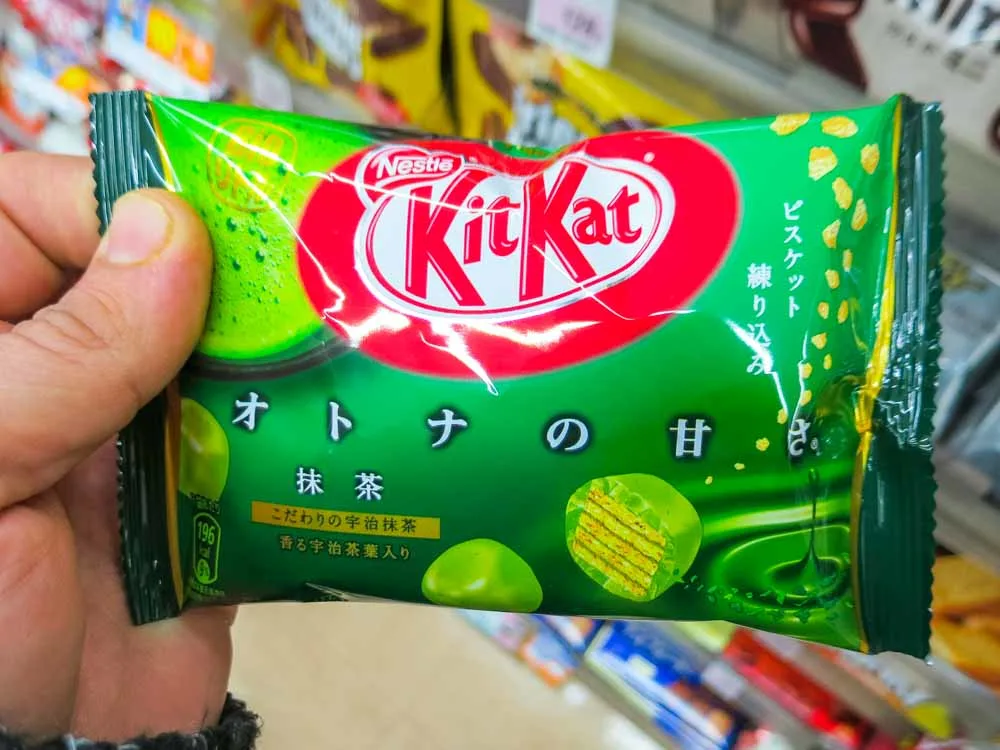
Candy in Japan is both wonderfully colorful and colorfully wonderful. Options range from simple chocolate bars to gummies that look like sushi. But for many who travel to Japan, Kit-Kats are the Japanese candy holy grail.
Kit-Kat bars in Japan are similar to Kit-Kats sold around the world except that the variety of flavors goes way beyond milk, white and dark chocolate. In fact, Japan has more than 300 flavors! Some like cherry blossom are seasonal while others like matcha are available year round.
Buy a variety pack of Japanese Kit-Kat bars from Amazon to sample at home.
30. Cheesecake
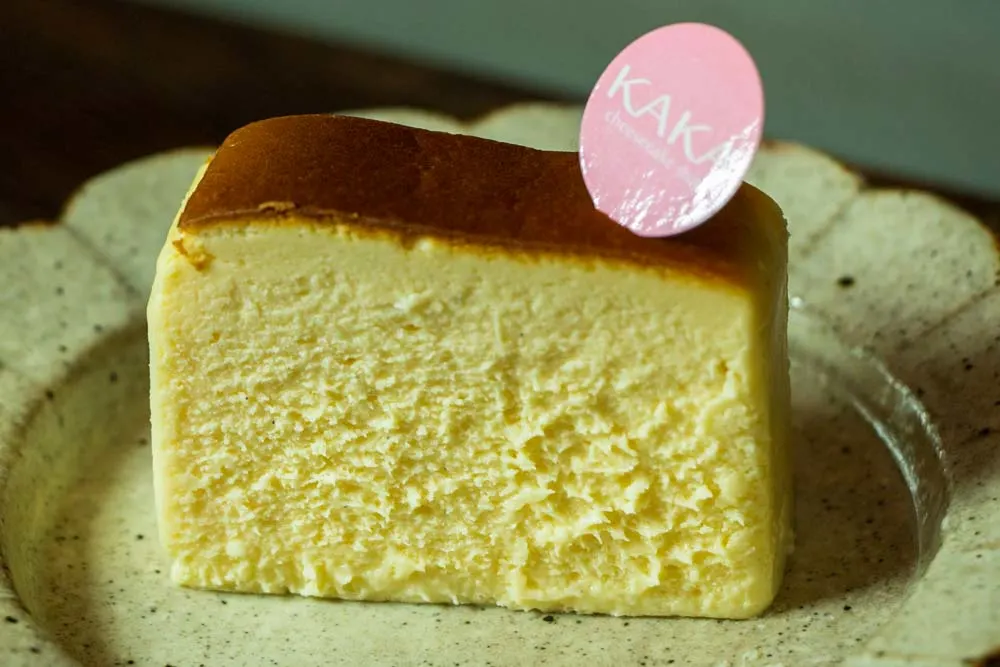
We first realized the popularity of cheesecake in Japan when we saw a line snaking around a Tokyo block near Shibuya Crossing and realized that it was people queuing for cheesecake. Prior to that observation, we thought that cheesecake’s popularity was specific to New York City.
As it turns out, cheesecake has been popular in Japan since it debuted as a dessert in Fukuoka in the 1940’s. We tasted-tested a slice made with four types of cheese for ‘research purposes’ during our Fukuoka visit and found it to be lighter and spongier than its New York cousin
Fun Fact
Greek bakers get credit for inventing cheesecake more than 2,000 years ago. Both the Japanese and American versions are 20th century creations.
31. Honey Toast
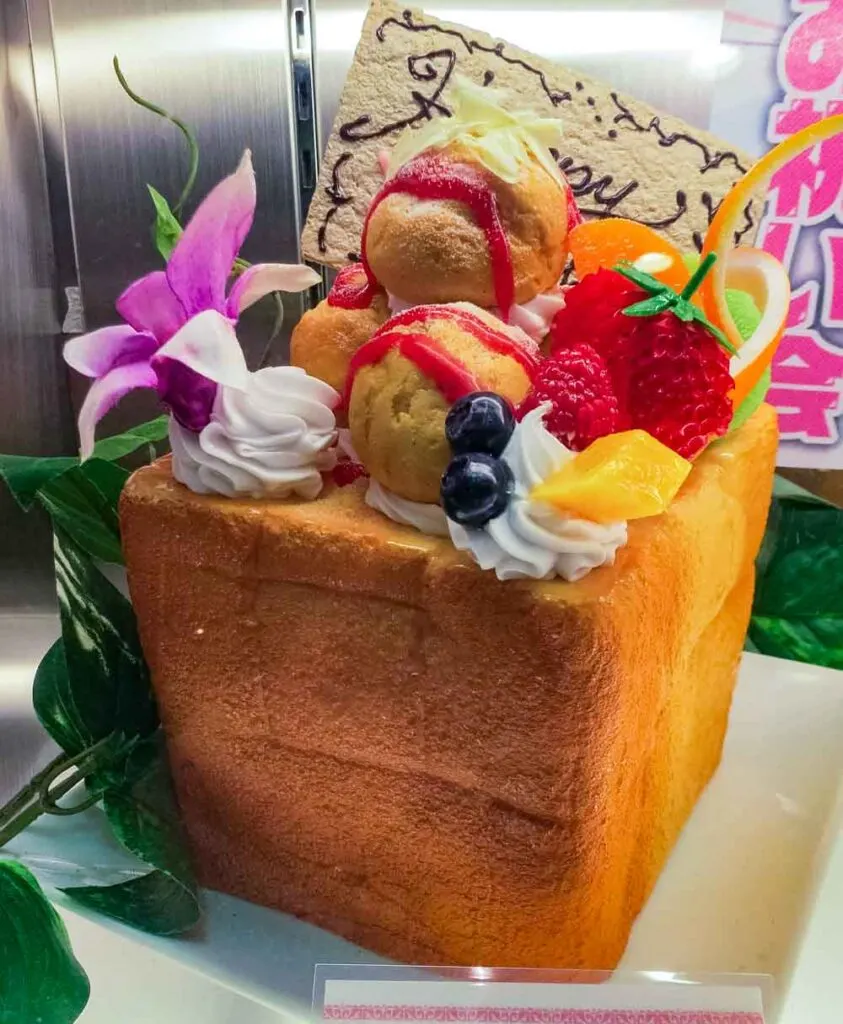
Honey toast is a dessert that’s meant to be shared. Japanese bakers caramelize a loaf of white bread with honey and butter before decorating it with toppings like ice cream, fruit and whipped cream. This dessert is also called brick toast, probably in reference to its weight and shape.
Originally invented in Tokyo’s Shibuya neighborhood, the fanciful dessert is available throughout the country in cafes and karaoke bars. You can find honey toast in Japan if you look for it. Just don’t try to eat it alone.
Pro Tip
Order honey toast if you happen to be in Japan for your birthday. It’s ideal for this type of festive celebration.
32. Dorayaki
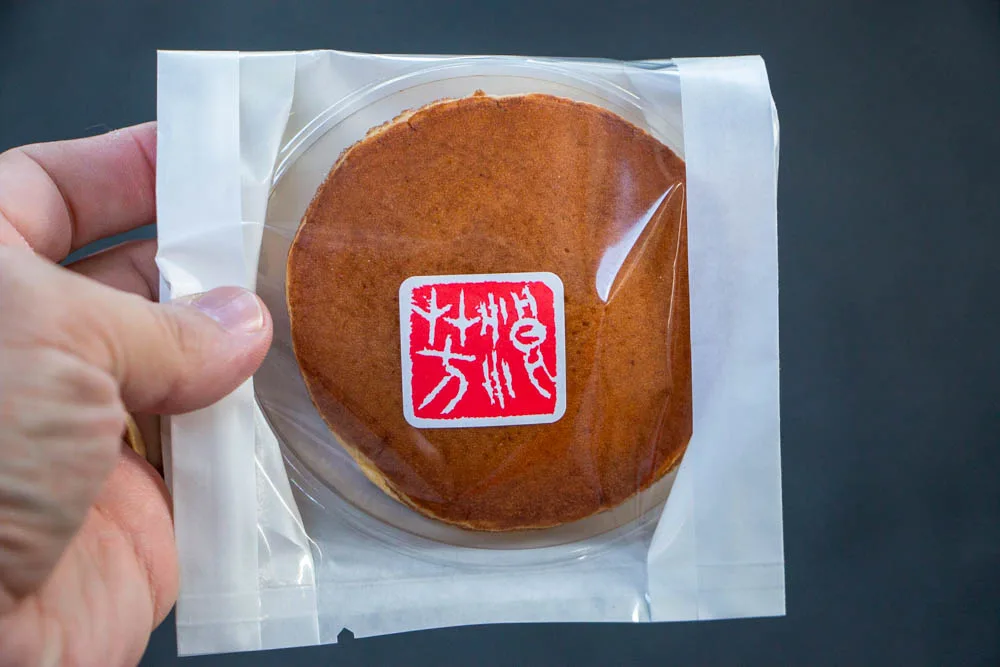
The dorayaki is a wagashi pastry that connects two pancakes with red bean paste filling. It’s also a pastry with a past.
Legend attributes the dorayaki’s creation to an ancient Samurai named Benkiai. For many years, the pastry was just one layer until Usagiya, a Tokyo confectionary shop, created a sandwich version in the early 20th century.
Usagiya’s version has become the global standard. We even ate a sandwich-like dorayaki in a Paris ramen shop.
Watch the movie Sweet Bean on Amazon. We were inspired to try a dorayaki after watching this movie at a film festival.
33. Fancy Fruit
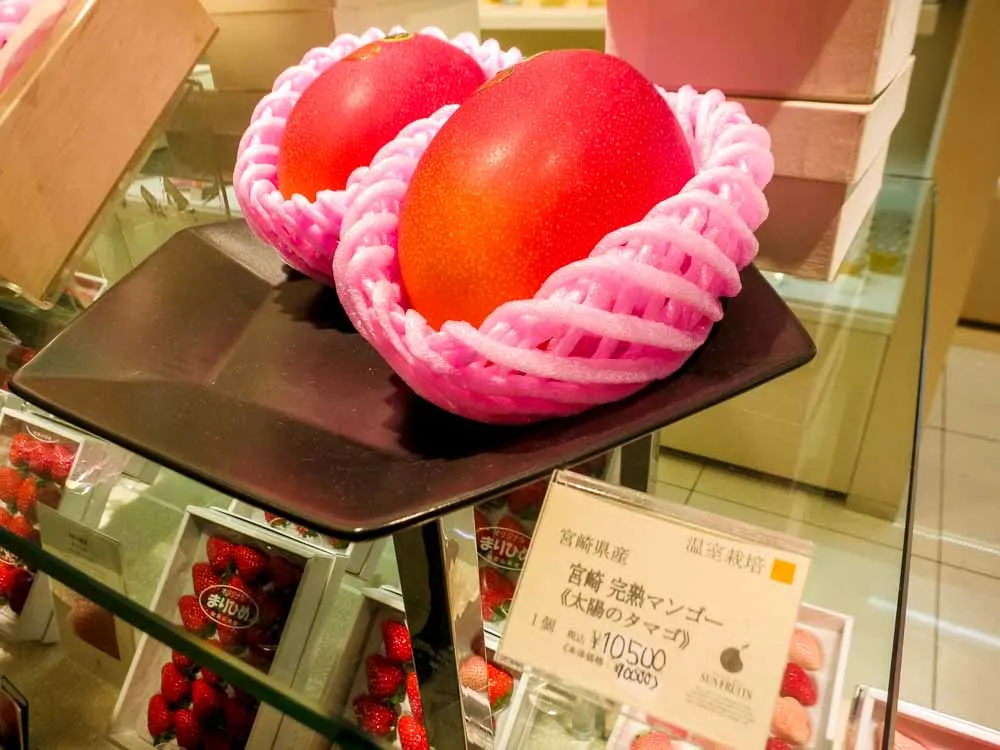
Would you spend $100 for a special piece of fruit? How about $1,000? In Japan, both of these prices are realistic when it comes to certain fruits like Yubari King melons and Sekai Ichi apples.
Sure, there are less expensive fruits available in Japan. But it would be tacky to give those as gifts to your hosts. Plus, they might have blemishes.
Pro Tip
We don’t actually recommend eating expensive fruit for dessert. Instead, take a photo of the price tag and tell your friends about it later.
34. Mochi
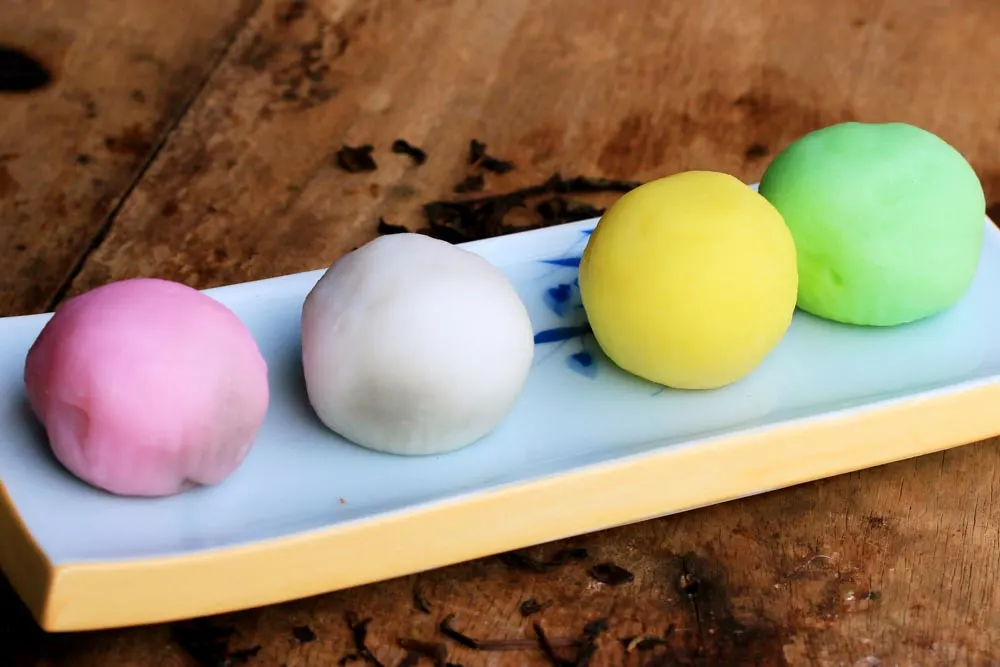
Popular all year long but especially at New Year’s celebrations, mochi cakes have been part of Japan’s culinary culture for centuries. And, surprise surprise, mochi is yet another Japanese food inspired by China.
Discover more than 100 of the best desserts around the world.
These tiny treats have a simple list of ingredients that includes rice, water, sugar, and cornstarch. However, mochi flavors run the gamut and include fillings like black sesame, chocolate, matcha, red bean, strawberry and vanilla.
Pro Tip
Try mochi filled with ice cream for a refreshing dessert that won’t melt in your hands.
Japanese Drinks
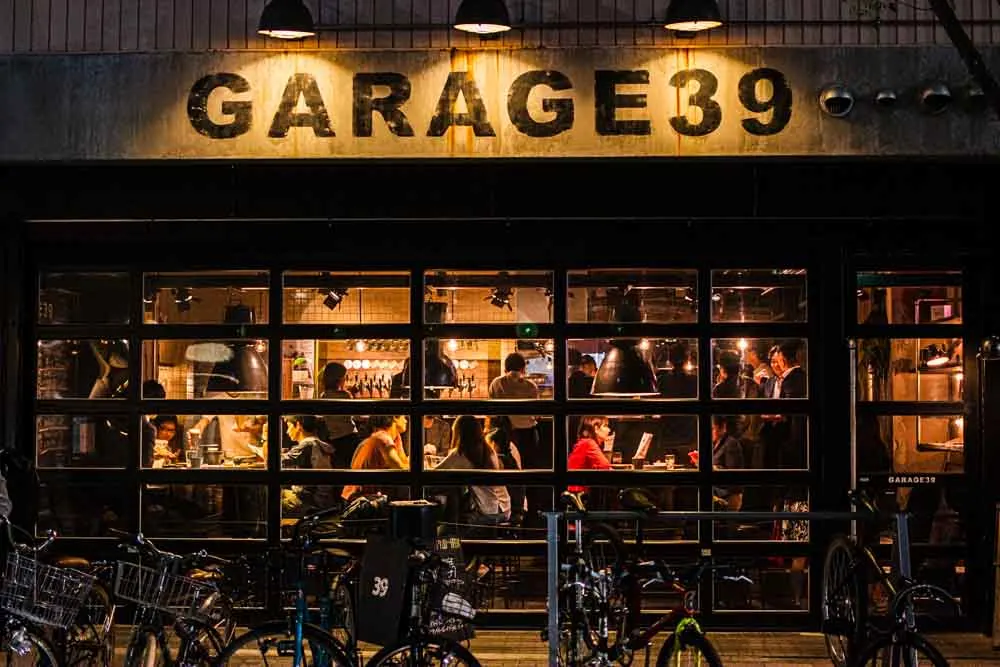
Considering the variety of Japanese food options, it only makes sense that Japan has a myriad of drinks both with and without alcohol.
These are our three favorite beverages to drink in Japan and the ones you shouldn’t miss during your trip:
35. Matcha
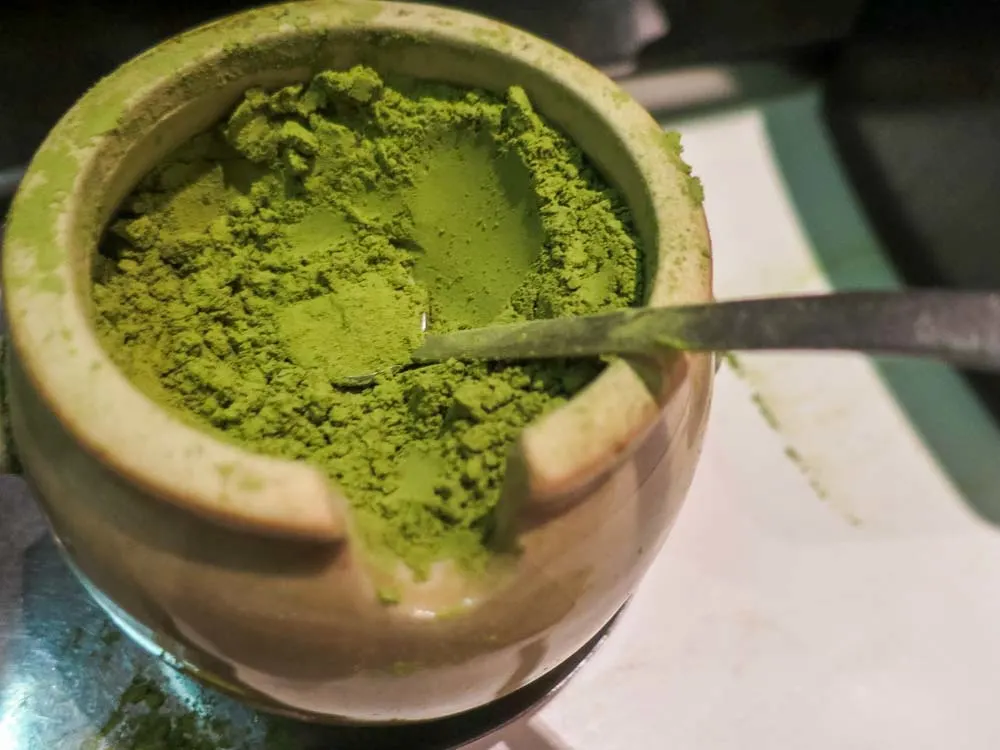
More than just an ingredient in Kat-Kat bars and mochi cakes, matcha is the powder used to make Japan’s most traditional green tea. Japanese people have been drinking this calming beverage for centuries and its culinary importance can’t be overstated.
Food travelers can drink green tea for breakfast, with sushi or at a Japanese tea ceremony. They also order matcha frappuccinos at the country’s ubiquitous Starbucks locations. In other words, green tea is anywhere and everywhere in Japan.
Pro Tip
In addition to its many health benefits, matcha contains caffeine if that’s important to you. (It certainly is to us.)
36. Sake
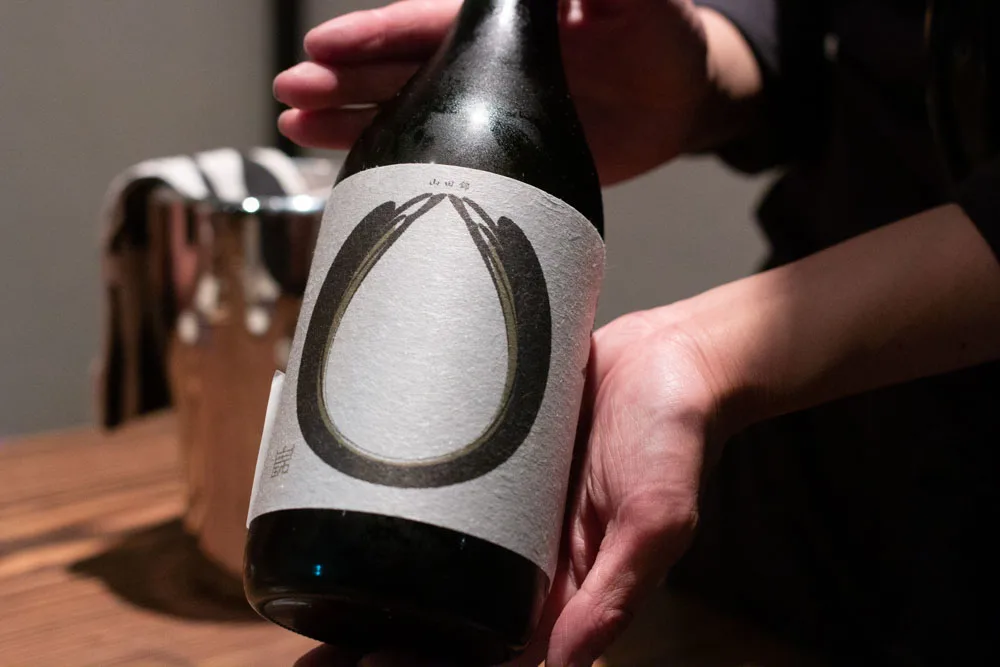
Known as nihonshu in Japan, sake is Japan’s second most popular alcoholic beverage after beer. Made with just four ingredients (rice, koji mold, water and yeast), sake is a fermented beverage. However, unlike wine and beer, sake is equally enjoyable to drink whether served cold or hot.
Although we imbibed sake at Japanese restaurants in Montreal, Las Vegas and Philadelphia prior to our first trip to Japan, we never truly appreciated the beauty of drinking quality sake until our kaiseki meal in Kyoto. What a revelation! It’s no wonder that the Japanese have been drinking sake since the third century.
Fun Fact
Sake is a great edible souvenir that you can drink at home and add to cocktail recipes.
37. Craft Beer
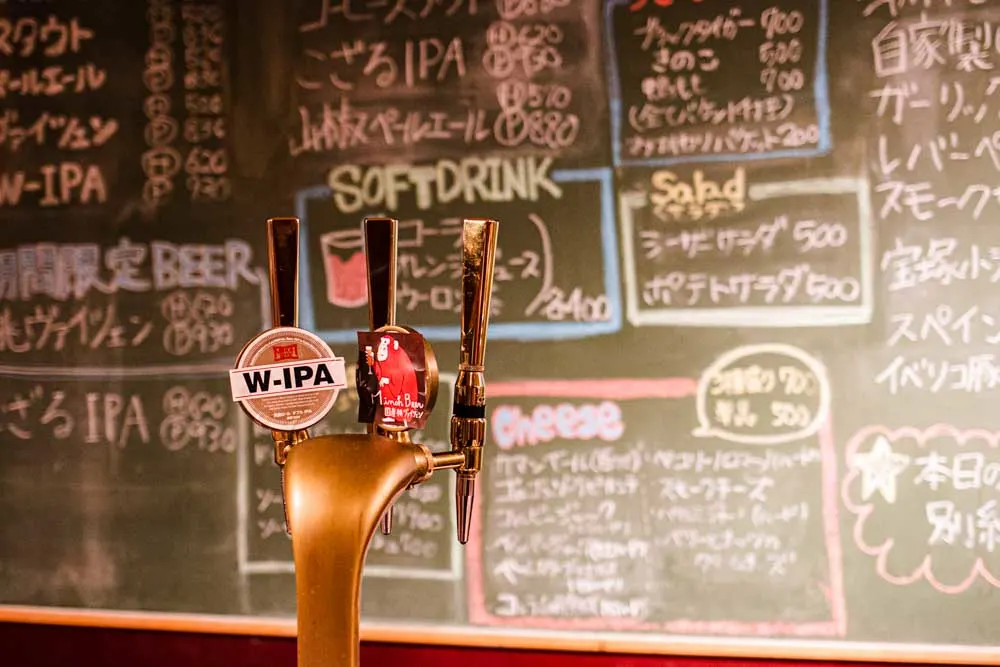
Beer has been popular in Japan since Dutch traders introduced the malty beverage back in the 17th century. A staple at izakayas and sporting events, beer is more popular than every other alcoholic beverage including sake.
While commodity Japanese beers like Asahi, Kirin and Sapporo are available at sushi bars around the world, these aren’t the best beers to drink in Japan. Instead, beer enthusiasts can enjoy a growing selection of Japanese made craft beers like Minoh and Hitachino.
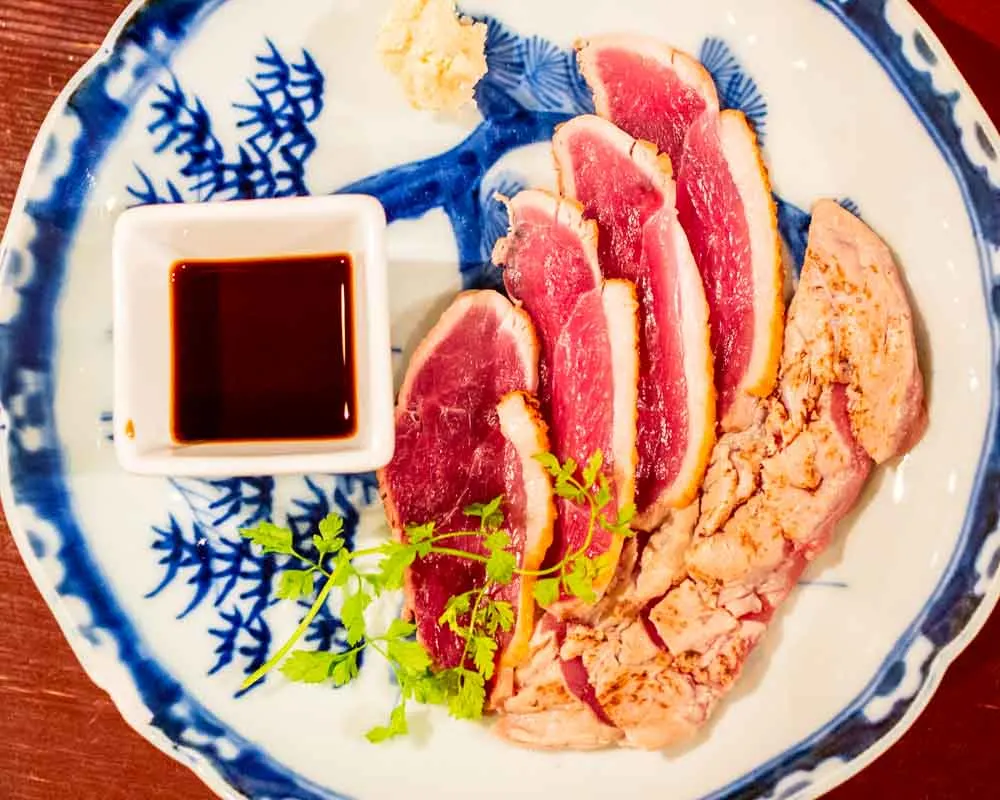
We’re pleased to report that both craft beer breweries and craft beer bars have grown in popularity since Japan deregulated beer production in 1994. Just like food, the Japanese make great craft beer that pairs well with Japanese snacks.
Pro Tip
Say kanpai when when you toast in Japan. It’s the Japanese equivalent to saying ‘cheers’.
Frequently Asked Questions
Japanese food, an Asian cuisine that’s developed over centuries, has roots entrenched in the concept of washoku. Literally translating to ‘Japanese food’, washoku is a harmonious way of eating simple, seasonal ingredients like rice, vegetables and seafood.
Sushi and ramen have both achieved massive global popularity. Other popular Japanese dishes include curry rice, miso soup, okonomiyaki, sashimi, soba, tempura and yakitori.
Yes. The Japanese cuisine offers a balanced food set that features fish, meat, vegetables and rice. Most Japanese ingredients are fresh and natural.
No. Japanese food is not traditionally spicy.
Video Recap

About the Authors
Daryl and Mindi Hirsch
Saveur Magazine’s BEST TRAVEL BLOG award winners Daryl and Mindi Hirsch share their culinary travel experiences and recipes on the 2foodtrippers website. Since launching the site in 2012, they’ve traveled to over 40 countries in their quest to bring readers a unique taste of the world.
Disclosures
Article Updates
We update our articles regularly. Some updates are major while others are minor link changes and spelling corrections. Let us know if you see anything that needs to be updated in this article.
Funding
We purchased and ate the food featured in this article.
Original Publication Date: December 27, 2020
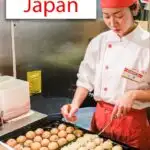
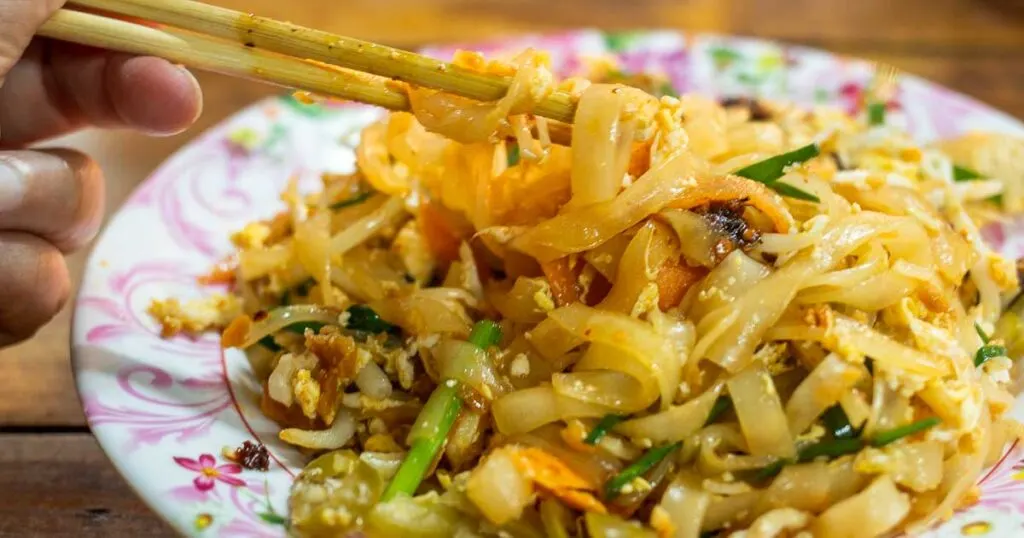
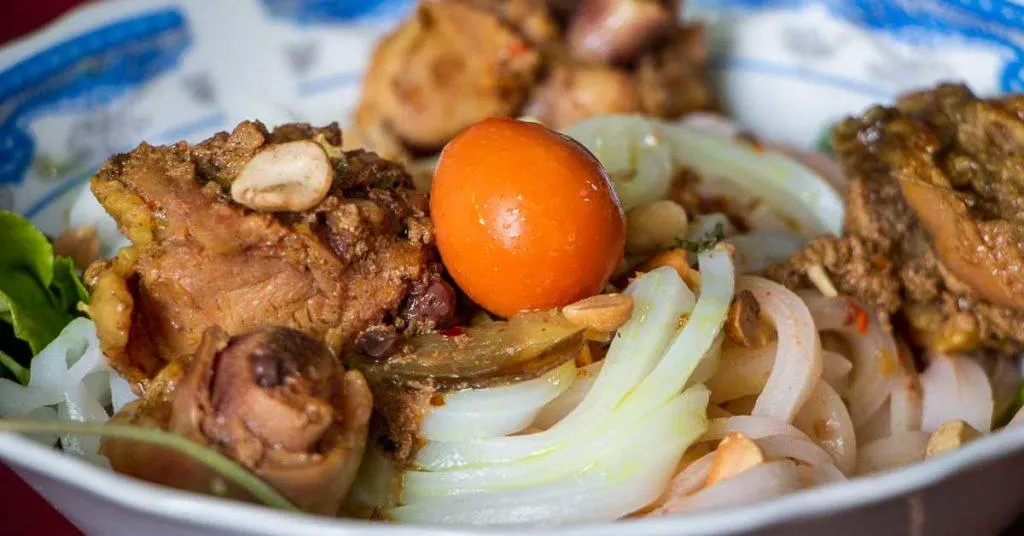
KC
Thursday 6th of October 2022
Nobody fries tempura or anything in sesame oil. Sesame oil breaks down when heated and it's too thick/heavy. It's used cold as a flavoring, like for oshitashi or added to salad dressing. Japanese uses a light veg oil for frying - as does the rest of the world.
Bad erroneous info.
Daryl and Mindi Hirsch
Friday 7th of October 2022
We totally agree. We don't know how that mistake was made. (We probably didn't see that in the edit.) Thanks for pointing that out and thanks for reading!